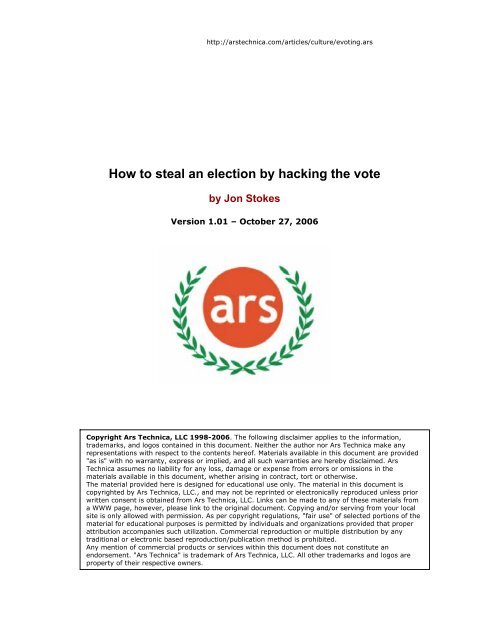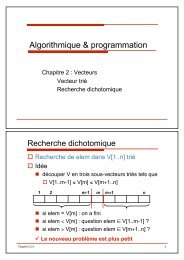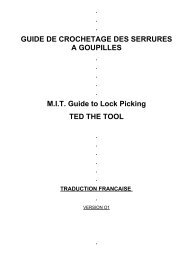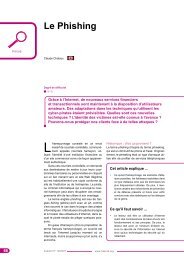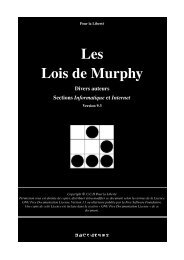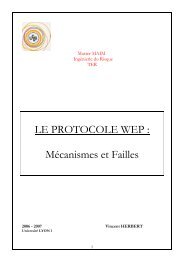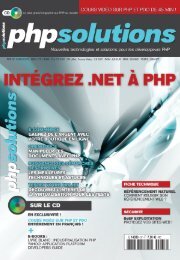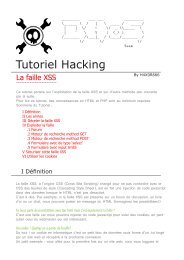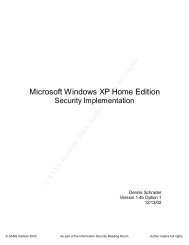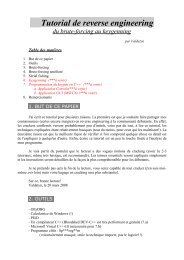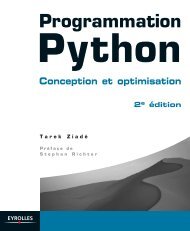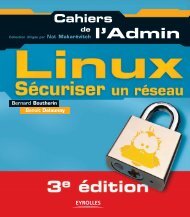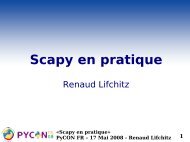How to Steal an Election by Hacking the Vote - repo.zenk-securit...
How to Steal an Election by Hacking the Vote - repo.zenk-securit...
How to Steal an Election by Hacking the Vote - repo.zenk-securit...
You also want an ePaper? Increase the reach of your titles
YUMPU automatically turns print PDFs into web optimized ePapers that Google loves.
http://arstechnica.com/articles/culture/evoting.ars<br />
<strong>How</strong> <strong>to</strong> steal <strong>an</strong> election <strong>by</strong> hacking <strong>the</strong> vote<br />
<strong>by</strong> Jon S<strong>to</strong>kes<br />
Version 1.01 – Oc<strong>to</strong>ber 27, 2006<br />
Copyright Ars Technica, LLC 1998-2006. The following disclaimer applies <strong>to</strong> <strong>the</strong> information,<br />
trademarks, <strong>an</strong>d logos contained in this document. Nei<strong>the</strong>r <strong>the</strong> author nor Ars Technica make <strong>an</strong>y<br />
representations with respect <strong>to</strong> <strong>the</strong> contents hereof. Materials available in this document are provided<br />
"as is" with no warr<strong>an</strong>ty, express or implied, <strong>an</strong>d all such warr<strong>an</strong>ties are here<strong>by</strong> disclaimed. Ars<br />
Technica assumes no liability for <strong>an</strong>y loss, damage or expense from errors or omissions in <strong>the</strong><br />
materials available in this document, whe<strong>the</strong>r arising in contract, <strong>to</strong>rt or o<strong>the</strong>rwise.<br />
The material provided here is designed for educational use only. The material in this document is<br />
copyrighted <strong>by</strong> Ars Technica, LLC., <strong>an</strong>d may not be reprinted or electronically reproduced unless prior<br />
written consent is obtained from Ars Technica, LLC. Links c<strong>an</strong> be made <strong>to</strong> <strong>an</strong>y of <strong>the</strong>se materials from<br />
a WWW page, however, please link <strong>to</strong> <strong>the</strong> original document. Copying <strong>an</strong>d/or serving from your local<br />
site is only allowed with permission. As per copyright regulations, "fair use" of selected portions of <strong>the</strong><br />
material for educational purposes is permitted <strong>by</strong> individuals <strong>an</strong>d org<strong>an</strong>izations provided that proper<br />
attribution accomp<strong>an</strong>ies such utilization. Commercial reproduction or multiple distribution <strong>by</strong> <strong>an</strong>y<br />
traditional or electronic based reproduction/publication method is prohibited.<br />
Any mention of commercial products or services within this document does not constitute <strong>an</strong><br />
endorsement. "Ars Technica" is trademark of Ars Technica, LLC. All o<strong>the</strong>r trademarks <strong>an</strong>d logos are<br />
property of <strong>the</strong>ir respective owners.<br />
Copyright © 1998-2006 Ars Technica, LLC<br />
1
http://arstechnica.com/articles/culture/evoting.ars<br />
<strong>How</strong> <strong>to</strong> steal <strong>an</strong> election <strong>by</strong> hacking <strong>the</strong> vote<br />
By Jon S<strong>to</strong>kes<br />
What if I <strong>to</strong>ld you that it would take only one person—one highly motivated, but only<br />
moderately skilled bad apple, with ei<strong>the</strong>r authorized or unauthorized access <strong>to</strong> <strong>the</strong><br />
right comp<strong>an</strong>y's internal computer network—<strong>to</strong> steal a statewide election? You might<br />
think I was crazy, or alarmist, or just talking about something that's only a remote,<br />
highly <strong>the</strong>oretical possibility. You also probably would think I was being really over<strong>the</strong>-<strong>to</strong>p<br />
if I <strong>to</strong>ld you that, without sweeping <strong>an</strong>d very costly ch<strong>an</strong>ges <strong>to</strong> <strong>the</strong> Americ<strong>an</strong><br />
elec<strong>to</strong>ral process, this scenario is almost certain <strong>to</strong> play out at some point in <strong>the</strong><br />
future in some county or state in America, <strong>an</strong>d that after it happens not only will we<br />
not have a clue as <strong>to</strong> what has taken place, but if we do get suspicious <strong>the</strong>re will be<br />
no way <strong>to</strong> prove <strong>an</strong>ything. You certainly wouldn't w<strong>an</strong>t <strong>to</strong> believe me, <strong>an</strong>d I don't<br />
blame you.<br />
So what if I <strong>to</strong>ld you that one highly motivated <strong>an</strong>d moderately skilled bad apple<br />
could cause hundreds of millions of dollars in damage <strong>to</strong> America's private sec<strong>to</strong>r <strong>by</strong><br />
unleashing a Windows virus from <strong>the</strong> safety of his parents' basement, <strong>an</strong>d that m<strong>an</strong>y<br />
of <strong>the</strong> victims in <strong>the</strong> attack would never know that <strong>the</strong>y'd been compromised? Before<br />
<strong>the</strong> rise of <strong>the</strong> Internet, this scenario also might've been considered alarmist folly <strong>by</strong><br />
most, but now we know that it's all <strong>to</strong>o real.<br />
Th<strong>an</strong>ks <strong>to</strong> <strong>the</strong> recent <strong>an</strong>d rapid adoption of direct-recording electronic (DRE) voting<br />
machines in states <strong>an</strong>d counties across America, <strong>the</strong> two scenarios that I just<br />
outlined have now become siblings (perhaps even fraternal twins) in <strong>the</strong> same large,<br />
unhappy family of information <strong>securit</strong>y (infosec) challenges. Our national election<br />
infrastructure is now largely <strong>an</strong> information technology infrastructure, so <strong>the</strong> problem<br />
of keeping our elections free of vote fraud is now <strong>an</strong> information <strong>securit</strong>y problem. If<br />
you've been keeping track of <strong>the</strong> news in <strong>the</strong> past few years, with its weekly lit<strong>an</strong>y of<br />
high-profile breaches in public- <strong>an</strong>d private-sec<strong>to</strong>r networks, <strong>the</strong>n you know how well<br />
we're (not) doing on <strong>the</strong> infosec front.<br />
Over <strong>the</strong> course of almost eight years of <strong>repo</strong>rting for Ars Technica, I've followed <strong>the</strong><br />
merging of <strong>the</strong> areas of election <strong>securit</strong>y <strong>an</strong>d information <strong>securit</strong>y, a merging that<br />
was accelerated much <strong>to</strong>o rapidly in <strong>the</strong> wake of <strong>the</strong> 2000 presidential election. In all<br />
this time, I've yet <strong>to</strong> find a good way <strong>to</strong> convey <strong>to</strong> <strong>the</strong> non-technical public how well<br />
<strong>an</strong>d truly screwed up we presently are, six years after <strong>the</strong> Florida recount. So now<br />
it's time <strong>to</strong> hit <strong>the</strong> p<strong>an</strong>ic but<strong>to</strong>n: In this article, I'm going <strong>to</strong> show you how <strong>to</strong><br />
steal <strong>an</strong> election.<br />
Now, I won't be giving you <strong>the</strong> kind of "push this, pull here" instructions for cracking<br />
specific machines that you c<strong>an</strong> find scattered all over <strong>the</strong> Internet, in alarmingly<br />
lengthy PDF <strong>repo</strong>rts that detail vulnerability after vulnerability <strong>an</strong>d exploit after<br />
exploit. (See <strong>the</strong> bibliography at <strong>the</strong> end of this article for that kind of information.)<br />
And I certainly won't be linking <strong>to</strong> <strong>an</strong>y of <strong>the</strong> leaked Diebold source code, which is<br />
available in various corners of <strong>the</strong> online world. What I'll show you instead is a road<br />
map <strong>to</strong> <strong>the</strong> brave new world of electronic election m<strong>an</strong>ipulation, with just enough<br />
nuts-<strong>an</strong>d-bolts detail <strong>to</strong> help you underst<strong>an</strong>d why things work <strong>the</strong> way <strong>the</strong>y do.<br />
Copyright © 1998-2006 Ars Technica, LLC<br />
2
http://arstechnica.com/articles/culture/evoting.ars<br />
Along <strong>the</strong> way, I'll also show you just how m<strong>an</strong>y different h<strong>an</strong>ds <strong>to</strong>uch <strong>the</strong>se<br />
electronic voting machines before <strong>an</strong>d after a vote is cast, <strong>an</strong>d I'll lay out just how<br />
vulnerable a DRE-based elections system is <strong>to</strong> what e-voting researchers have<br />
dubbed "wholesale fraud," i.e., <strong>the</strong> ability of <strong>an</strong> individual or a very small group <strong>to</strong><br />
steal <strong>an</strong> entire election <strong>by</strong> making subtle ch<strong>an</strong>ges in <strong>the</strong> right places.<br />
So let's get right down <strong>to</strong> business <strong>an</strong>d meet <strong>the</strong> <strong>to</strong>ols that we're going <strong>to</strong> use <strong>to</strong> flip<br />
a race in favor of our preferred c<strong>an</strong>didate.<br />
Note: I'm not in <strong>an</strong>y way encouraging <strong>an</strong>yone <strong>to</strong> actually go out <strong>an</strong>d steal <strong>an</strong><br />
election. This article is intended solely as a guide <strong>to</strong> <strong>the</strong> kinds of information <strong>an</strong>d<br />
techniques that election thieves already have available, <strong>an</strong>d not as <strong>an</strong> incitement <strong>to</strong><br />
or <strong>an</strong> aid for committing crimes.<br />
E-voting 101: <strong>to</strong>uch-screen machines <strong>an</strong>d optical sc<strong>an</strong>ners<br />
There are m<strong>an</strong>y different types of electronic voting machines available from a whole<br />
host of large <strong>an</strong>d small vendors, but this article will focus primarily on one type: <strong>the</strong><br />
direct-recording electronic (DRE) voting machine. None<strong>the</strong>less, optical sc<strong>an</strong>ners are<br />
vulnerable <strong>to</strong> m<strong>an</strong>y of <strong>the</strong> same exploits that I'll describe for <strong>the</strong> DRE; <strong>the</strong> only<br />
difference is that optical sc<strong>an</strong>ners leave a reliable paper audit trail that could be used<br />
<strong>to</strong> tell if <strong>an</strong> election has been tampered with, but such audits must actually be carried<br />
out <strong>to</strong> have <strong>an</strong>y impact.<br />
DREs <strong>an</strong>d optical sc<strong>an</strong>ners are far <strong>an</strong>d away <strong>the</strong> two most popular types of voting<br />
machines in use <strong>to</strong>day. The following statistics break down <strong>by</strong> popularity <strong>the</strong> types of<br />
voting machines used in 2006:<br />
Voting equipment <strong>repo</strong>rted for <strong>the</strong> 2006 elections<br />
Type of<br />
voting<br />
Counties Registered voters*<br />
equipment Number Percentage Number Percentage<br />
Punch card 124 3.98 5,166,247 3.03<br />
Lever 119 3.82 17,356,729 10.18<br />
Paper ballots 176 5.65 653,704 0.38<br />
Optical sc<strong>an</strong> 1,502 48.23 69,517,991 40.79<br />
Electronic 1,050 33.72 66,573,736 39.06<br />
Mixed 143 4.59 11,154,765 6.55<br />
Total 3,114 100 170,423,172 100<br />
* Registered voter counts are from <strong>the</strong> November 2004 general elections<br />
Source: <strong>Election</strong> Data Systems<br />
Just <strong>to</strong> orient ourselves <strong>to</strong> <strong>the</strong> basics of electronic voting, let's take a brief look at<br />
how votes are cast <strong>an</strong>d counted using each type of machine.<br />
Optical sc<strong>an</strong> machines<br />
In order <strong>to</strong> cast a vote using <strong>an</strong> optical sc<strong>an</strong> machine, a voter follows <strong>the</strong> three steps<br />
shown in Figure 1.<br />
Copyright © 1998-2006 Ars Technica, LLC<br />
3
1<br />
2<br />
3<br />
C<strong>an</strong>didate<br />
C<strong>an</strong>didate<br />
C<strong>an</strong>didate<br />
C<strong>an</strong>didate<br />
C<strong>an</strong>didate<br />
Board of<br />
<strong>Election</strong>s<br />
http://arstechnica.com/articles/culture/evoting.ars<br />
C<strong>an</strong>didate C<strong>an</strong>didate<br />
C<strong>an</strong>didate<br />
C<strong>an</strong>didate<br />
C<strong>an</strong>didate C<strong>an</strong>didate<br />
C<strong>an</strong>didate<br />
S<strong>an</strong>Disk<br />
C<strong>an</strong>didate<br />
C<strong>an</strong>didate<br />
C<strong>an</strong>didate<br />
C<strong>an</strong>didate<br />
C<strong>an</strong>didate<br />
Figure 1: Electronic voting using <strong>an</strong> optical sc<strong>an</strong>ner<br />
The three steps depicted in Figure 1 are as follows:<br />
1. After receiving a paper ballot from poll workers, <strong>the</strong> voter marks her<br />
choices on <strong>the</strong> ballot <strong>by</strong> filling in bubbles with a pen. (An optical sc<strong>an</strong> ballot<br />
looks <strong>an</strong>d functions much like <strong>the</strong> multiple choice bubble sheets used in<br />
st<strong>an</strong>dardized tests.)<br />
2. The marked ballot is <strong>the</strong>n fed in<strong>to</strong> <strong>the</strong> optical sc<strong>an</strong> voting machine, where<br />
<strong>the</strong> voter's choices are tr<strong>an</strong>slated in <strong>the</strong> 1s <strong>an</strong>d 0s of computer l<strong>an</strong>guage<br />
<strong>an</strong>d s<strong>to</strong>red, along with <strong>the</strong> rest of <strong>the</strong> votes cast on that machine, in <strong>the</strong><br />
machine's internal memory. (I've depicted <strong>the</strong> internal s<strong>to</strong>rage as a<br />
S<strong>an</strong>Disk Flash PCMCIA card of <strong>the</strong> type commonly used in <strong>the</strong> Diebold DRE<br />
described below, but o<strong>the</strong>r s<strong>to</strong>rage formats are possible.)<br />
3. At <strong>the</strong> end of <strong>the</strong> election, when all of <strong>the</strong> votes have been cast <strong>an</strong>d are<br />
s<strong>to</strong>red in <strong>the</strong> optical sc<strong>an</strong> machines, <strong>the</strong> contents of <strong>the</strong> machines' internal<br />
s<strong>to</strong>rage devices are <strong>the</strong>n tr<strong>an</strong>smitted <strong>to</strong> <strong>the</strong> county Board of <strong>Election</strong>s<br />
(BOE) for tallying <strong>an</strong>d archiving. The marked paper ballots are also<br />
archived, in case a m<strong>an</strong>ual audit is dem<strong>an</strong>ded.<br />
There are some variations in <strong>the</strong> process listed above (e.g., all of <strong>the</strong> votes in a<br />
single precinct c<strong>an</strong> be tallied before being sent off <strong>to</strong> <strong>the</strong> BOE), but in general it<br />
describes overall movement of votes in <strong>the</strong> voting process.<br />
Direct-recording electronic (DRE) machines<br />
The steps involved in voting with DREs are similar <strong>to</strong> those described for optical sc<strong>an</strong><br />
machines, but <strong>the</strong>re are some critical differences. Figure 2 illustrates what we might<br />
call <strong>the</strong> "life-cycle of a vote" in <strong>the</strong> DRE-based voting process.<br />
S<strong>an</strong>Disk<br />
4
http://arstechnica.com/articles/culture/evoting.ars<br />
Figure 2: Electronic voting using a DRE<br />
The steps depicted in Figure 2 are as follows:<br />
1<br />
2<br />
3<br />
C<strong>an</strong>didate<br />
C<strong>an</strong>didate<br />
C<strong>an</strong>didate<br />
C<strong>an</strong>didate<br />
C<strong>an</strong>didate<br />
Board of<br />
<strong>Election</strong>s<br />
1. The voter loads his ballot on<strong>to</strong> <strong>the</strong> DRE's screen <strong>by</strong> inserting in<strong>to</strong> <strong>the</strong><br />
machine <strong>the</strong> special smart card that he was issued <strong>by</strong> a poll worker. When<br />
<strong>the</strong> ballot screen appears, <strong>the</strong> voter marks his selections <strong>by</strong> <strong>to</strong>uching <strong>the</strong><br />
appropriate boxes on <strong>the</strong> screen.<br />
2. The votes are read from <strong>the</strong> screen <strong>by</strong> <strong>the</strong> machine's vote recording<br />
software <strong>an</strong>d recorded directly on<strong>to</strong> <strong>the</strong> DRE's internal s<strong>to</strong>rage, where<br />
<strong>the</strong>y're s<strong>to</strong>red along with <strong>the</strong> o<strong>the</strong>r votes that were cast on that machine.<br />
3. At <strong>the</strong> end of <strong>the</strong> election, when all of <strong>the</strong> votes have been cast <strong>an</strong>d are<br />
s<strong>to</strong>red in <strong>the</strong> DREs, <strong>the</strong> contents of <strong>the</strong> machines' internal s<strong>to</strong>rage devices<br />
are <strong>the</strong>n tr<strong>an</strong>smitted <strong>to</strong> <strong>the</strong> county Board of <strong>Election</strong>s (BOE) for tallying<br />
<strong>an</strong>d archiving.<br />
Note that <strong>the</strong> voter's choices are only recorded in one place: <strong>the</strong> internal s<strong>to</strong>rage of<br />
<strong>the</strong> DRE. Unlike <strong>the</strong> optical sc<strong>an</strong> machines, <strong>the</strong> DRE system provides no perm<strong>an</strong>ent,<br />
nonelectronic paper record of <strong>the</strong> voter's intended choices that c<strong>an</strong> be verified <strong>by</strong> <strong>the</strong><br />
voter <strong>an</strong>d <strong>the</strong>n archived for possible use in <strong>an</strong> audit.<br />
Now, <strong>the</strong> three-step process described above is vulnerable at multiple points in each<br />
stage. Here are just a few examples <strong>to</strong> illustrate what I'm talking about:<br />
Step 1: The machine could be tainted with vote-stealing software, or <strong>the</strong><br />
voter could taint <strong>the</strong> machine with vote-stealing software <strong>by</strong> gaining access<br />
<strong>to</strong> it.<br />
Step 2: If <strong>the</strong> machine is tainted, <strong>the</strong>n it c<strong>an</strong> incorrectly record <strong>the</strong> vote.<br />
Or, if <strong>the</strong> voter has m<strong>an</strong>aged <strong>to</strong> make a supervisor card for himself, he c<strong>an</strong><br />
vote multiple times, delete votes, or disable <strong>the</strong> machine entirely.<br />
Step 3: If <strong>the</strong> centralized machine that does <strong>the</strong> vote tallying is tainted,<br />
<strong>the</strong>n not only c<strong>an</strong> it skew <strong>the</strong> election results, but it c<strong>an</strong> also infect <strong>an</strong>y<br />
DRE that connects directly <strong>to</strong> it, or it c<strong>an</strong> taint <strong>an</strong>y s<strong>to</strong>rage card that's<br />
plugged in<strong>to</strong> it.<br />
You might think that <strong>the</strong> supervisor smartcard cloning, viruses, <strong>an</strong>d unauthorized<br />
accesses that I've described above are purely hypo<strong>the</strong>tical. If <strong>the</strong> DRE in question is<br />
<strong>the</strong> popular Diebold Accu<strong>Vote</strong> TS, <strong>the</strong>n <strong>the</strong>y're not at all hypo<strong>the</strong>tical. All of <strong>the</strong><br />
S<strong>an</strong>Disk<br />
S<strong>an</strong>Disk<br />
5
http://arstechnica.com/articles/culture/evoting.ars<br />
attacks that I just summarized, <strong>an</strong>d m<strong>an</strong>y more, have been implemented <strong>by</strong> multiple<br />
teams of <strong>securit</strong>y researchers. Just for kicks, take a break from reading <strong>an</strong>d go<br />
watch this little demonstration video.<br />
But before we talk in more detail about <strong>the</strong> Accu<strong>Vote</strong>, let's take a step back <strong>an</strong>d get<br />
a big-picture look at <strong>the</strong> kinds of new opportunities that <strong>the</strong> would-be election thief<br />
has at her disposal, th<strong>an</strong>ks <strong>to</strong> DREs.<br />
Bad apples <strong>an</strong>d barrel sizes, or how <strong>to</strong> do a lot with a little<br />
If we w<strong>an</strong>t <strong>to</strong> steal <strong>an</strong> election, <strong>the</strong>n ideally we w<strong>an</strong>t as few warm bodies in on <strong>the</strong><br />
scam as possible. All of <strong>the</strong> old-school election m<strong>an</strong>ipulation tricks, like voter<br />
intimidation, vote-buying, turn-out suppression, <strong>an</strong>d so on, require legions of<br />
volunteers who know exactly what's going on; but in <strong>the</strong> new era of electronic vote<br />
tampering, <strong>an</strong> election thief c<strong>an</strong> do a whole lot more with a whole lot less.<br />
<strong>Election</strong> <strong>securit</strong>y experts break down voting fraud types in<strong>to</strong> two main categories,<br />
based on how m<strong>an</strong>y bad apples it takes <strong>to</strong> swing <strong>an</strong> election: retail fraud <strong>an</strong>d<br />
wholesale fraud. Retail fraud is <strong>the</strong> kind of election fraud that's most familiar <strong>to</strong> us,<br />
because it has been around for <strong>the</strong> longest time. In general, retail fraud involves<br />
multiple bad apples at <strong>the</strong> precinct level, carrying out <strong>an</strong>y number of bad acts<br />
involving multiple voters <strong>an</strong>d voting machines. Some examples of retail fraud are<br />
ballot stuffing, restricting polling place access <strong>by</strong> me<strong>an</strong>s of intimidation, v<strong>an</strong>dalizing<br />
individual machines <strong>to</strong> make <strong>the</strong>m unusable, counterfeiting ballots, <strong>an</strong>d so on.<br />
Wholesale fraud is relatively new, <strong>an</strong>d it involves a single bad apple who c<strong>an</strong> affect<br />
<strong>an</strong> election's outcome at <strong>the</strong> precinct, county, <strong>an</strong>d state levels. (Actually, <strong>by</strong> this<br />
definition, wholesale fraud is as old as <strong>the</strong> poll tax. But let's stick <strong>to</strong> wholesale fraud<br />
involving electronic voting machines for now.) So with wholesale fraud, one bad<br />
apple c<strong>an</strong> affect different barrels of various sizes, depending where in <strong>the</strong> election<br />
process she's placed.<br />
The table below breaks down <strong>the</strong> newer types of fraud that electronic voting<br />
machines have made available <strong>to</strong> election thieves:<br />
Wholesale <strong>an</strong>d retail fraud<br />
Wholesale Retail<br />
Detectable • Altering <strong>the</strong> vote<br />
tabulation process<br />
• Altering <strong>the</strong> record of<br />
tabulated results<br />
Undetectable • Altering <strong>the</strong> vote<br />
tabulation process<br />
• Altering <strong>the</strong> vote<br />
recording process<br />
• Altering <strong>the</strong> record of<br />
votes<br />
• Multiple voting<br />
• Deleting votes<br />
• Disabling a machine<br />
• Invalidating all <strong>the</strong> votes<br />
on a machine<br />
• Altering <strong>the</strong> vote<br />
recording process<br />
• Altering <strong>the</strong> record of<br />
votes<br />
In this table, "detectable" denotes inst<strong>an</strong>ces of tampering <strong>an</strong>d fraud where we could<br />
potentially know that something went wrong with <strong>the</strong> vote, even if we're not sure<br />
Copyright © 1998-2006 Ars Technica, LLC<br />
6
http://arstechnica.com/articles/culture/evoting.ars<br />
what has happened or how. Undetectable fraud denotes fraud that's absolutely<br />
impossible <strong>to</strong> detect after <strong>the</strong> fact (short of a whistleblower coming forth), <strong>an</strong>d that's<br />
functionally impossible <strong>to</strong> detect before <strong>the</strong> fact due <strong>to</strong> time <strong>an</strong>d resource constraints<br />
on pre-election machine testing.<br />
The scariest part of Table 2's list of e-voting fraud types is <strong>the</strong> box where <strong>the</strong><br />
"Undetectable" row <strong>an</strong>d <strong>the</strong> "Wholesale" column intersect. Undetectable wholesale<br />
fraud is <strong>the</strong> ultimate apocalyptic scenario for <strong>securit</strong>y <strong>an</strong>alysts, <strong>an</strong>d for democracy—<br />
it's <strong>the</strong> briefcase nuke in down<strong>to</strong>wn M<strong>an</strong>hatt<strong>an</strong>, or <strong>the</strong> hum<strong>an</strong>-tr<strong>an</strong>smissible bird flu<br />
strain in <strong>the</strong> international terminal of LAX.<br />
Because undetectable wholesale election fraud is <strong>the</strong> holy grail of <strong>an</strong>yone who w<strong>an</strong>ts<br />
<strong>to</strong> steal <strong>an</strong> election, I'll spend <strong>the</strong> rest of this article discussing it in some detail.<br />
Along <strong>the</strong> way, you'll also see that most of <strong>the</strong> attacks I'll cover c<strong>an</strong> also be carried<br />
out on <strong>the</strong> retail level, as well.<br />
Narrowing <strong>the</strong> focus: <strong>the</strong> Diebold Accu<strong>Vote</strong> TS<br />
Even after <strong>the</strong> passage of <strong>the</strong> Help America <strong>Vote</strong> Act (HAVA) in 2002, national<br />
election st<strong>an</strong>dards at all levels of <strong>the</strong> elec<strong>to</strong>ral process—site <strong>securit</strong>y, machine<br />
<strong>securit</strong>y, election procedures, auditability requirements, dispute resolution, etc.—are<br />
ei<strong>the</strong>r extremely weak or, in m<strong>an</strong>y cases, simply ignored <strong>by</strong> states <strong>an</strong>d counties.<br />
Because of <strong>the</strong> extraordinary variability of voting technologies <strong>an</strong>d procedures from<br />
state <strong>to</strong> state, <strong>the</strong> entire country presents a morass of special cases <strong>to</strong> <strong>the</strong> writer<br />
who would lay out a generally applicable scenario of electronic election <strong>the</strong>ft.<br />
Because <strong>the</strong> technologies, techniques, <strong>an</strong>d procedures at issue vary so widely, it's<br />
necessary for me <strong>to</strong> narrow <strong>the</strong> focus of <strong>the</strong> present discussion <strong>to</strong> one particular DRE<br />
voting machine: <strong>the</strong> Diebold Accu<strong>Vote</strong> TS.<br />
The Diebold Accu<strong>Vote</strong> TS is one of <strong>the</strong> most popular DRE voting machines currently<br />
in use. Georgia <strong>an</strong>d Maryl<strong>an</strong>d have both st<strong>an</strong>dardized on this model across <strong>the</strong> state,<br />
<strong>an</strong>d Diebold claims that over 130,000 of its Accu<strong>Vote</strong> TS <strong>an</strong>d TSx (<strong>an</strong> updated<br />
model) machines are now in use across America.<br />
Processor 118 MHz Hitachi SH3<br />
S<strong>to</strong>rage 16MB RAM, 32MB on-board Flash, 128K EPROM<br />
I/O Keyboard, modem (PCMCIA), IrDA, headphone jack<br />
Firmware Cus<strong>to</strong>m Diebold firmware<br />
Operating system Windows CE 3.0<br />
Application<br />
software<br />
Cus<strong>to</strong>m Diebold system software<br />
Display Touchscreen, <strong>the</strong>rmal roll printer (for printing a zero<br />
tape <strong>an</strong>d final vote tallies)<br />
The Accu<strong>Vote</strong> TS is also <strong>the</strong> DRE that has been subjected <strong>to</strong> <strong>the</strong> most scrutiny <strong>by</strong> <strong>the</strong><br />
infosec community, mainly because its source code has been widely available on <strong>the</strong><br />
Internet. Much of what I'll say about <strong>the</strong> Accu<strong>Vote</strong> will apply <strong>to</strong> o<strong>the</strong>r DRE systems as<br />
well. Some specific vulnerabilities, like <strong>the</strong> unencrypted ballot definition file described<br />
later, are probably peculiar <strong>to</strong> <strong>the</strong> Accu<strong>Vote</strong>, but m<strong>an</strong>y of <strong>the</strong> overall types of attacks<br />
enumerated here apply <strong>to</strong> o<strong>the</strong>r DREs. (It's hard <strong>to</strong> say which o<strong>the</strong>r o<strong>the</strong>r DREs are<br />
vulnerable <strong>to</strong> which attacks, because we don't have source code for <strong>the</strong> o<strong>the</strong>rs so it's<br />
harder <strong>to</strong> know how secure <strong>the</strong>y are.)<br />
Copyright © 1998-2006 Ars Technica, LLC<br />
7
http://arstechnica.com/articles/culture/evoting.ars<br />
Casting (<strong>an</strong>d cracking) a vote on <strong>the</strong> Diebold Accu<strong>Vote</strong> TS<br />
In a previous section, we went over <strong>the</strong> basics of voting on a DRE. Now let's step<br />
back a bit <strong>an</strong>d look at a picture of <strong>the</strong> entire voting process using <strong>an</strong> Accu<strong>Vote</strong>.<br />
1<br />
2<br />
3<br />
4<br />
5<br />
Figure 3: Electronic voting using a Diebold Accu<strong>Vote</strong> TS<br />
Here are <strong>the</strong> steps described in detail:<br />
1. After showing proper identification, <strong>the</strong> voter is issued <strong>an</strong> activated smart<br />
card. This card enables <strong>the</strong> voter <strong>to</strong> vote one ballot <strong>an</strong>d one ballot only.<br />
2. The voter inserts <strong>the</strong> smart card in<strong>to</strong> <strong>the</strong> machine. Once inserted, <strong>the</strong><br />
smart card tells <strong>the</strong> Accu<strong>Vote</strong> which races <strong>the</strong> voter is authorized <strong>to</strong> vote<br />
in. The Accu<strong>Vote</strong> <strong>the</strong>n loads <strong>the</strong> ballot definition file (BDF) that's<br />
appropriate for that voter. The Accu<strong>Vote</strong>'s internal software uses <strong>the</strong> BDF<br />
<strong>to</strong> display <strong>the</strong> ballot on <strong>the</strong> <strong>to</strong>uchscreen.<br />
3. The voter votes <strong>by</strong> <strong>to</strong>uching his selections on <strong>the</strong> screen. Once <strong>the</strong><br />
electronic ballot is complete, <strong>the</strong> machine asks <strong>the</strong> voter <strong>to</strong> verify his<br />
selections before recording <strong>the</strong>m directly on<strong>to</strong> <strong>an</strong> internal s<strong>to</strong>rage device.<br />
The Accu<strong>Vote</strong>'s internal s<strong>to</strong>rage device is a PCMCIA Flash memory card.<br />
4. The voter removes <strong>the</strong> smartcard, which is now deactivated <strong>an</strong>d c<strong>an</strong>not be<br />
used again until it is reactivated.<br />
5. The voter returns <strong>the</strong> smartcard <strong>to</strong> <strong>the</strong> poll worker, who <strong>the</strong>n reactivates it<br />
for issuing <strong>to</strong> <strong>an</strong>o<strong>the</strong>r voter.<br />
The voting process described here is vulnerable <strong>to</strong> multiple types of retail fraud at<br />
almost every point. Because <strong>the</strong> focus of this article is on wholesale fraud, I'm only<br />
8
http://arstechnica.com/articles/culture/evoting.ars<br />
going <strong>to</strong> briefly outline a few of <strong>the</strong> retail fraud mech<strong>an</strong>isms, just <strong>to</strong> give you a taste<br />
for Diebold's overall approach <strong>to</strong> <strong>securit</strong>y:<br />
• The Ohio Compuware <strong>repo</strong>rt describes how <strong>to</strong> turn a voter card in<strong>to</strong> a<br />
supervisor card, which c<strong>an</strong> <strong>the</strong>n be used <strong>to</strong> cast multiple votes, delete<br />
votes, or shut down <strong>the</strong> machine, using a PDA with a smartcard<br />
attachment.<br />
• In order <strong>to</strong> use a supervisor card <strong>to</strong> access <strong>the</strong> Accu<strong>Vote</strong>, you must first<br />
enter a four-digit PIN. In version of <strong>the</strong> machine that was in use as late as<br />
2003, <strong>the</strong> exact same supervisor PIN was hard-coded in<strong>to</strong> every single<br />
Accu<strong>Vote</strong> TS shipped nationwide. That PIN was 1111. (I am not making<br />
this up.) This is still <strong>the</strong> default PIN for <strong>the</strong>se machines, although <strong>the</strong><br />
county c<strong>an</strong> ch<strong>an</strong>ge it on a machine-<strong>by</strong>-machine basis if <strong>the</strong>y have <strong>the</strong><br />
m<strong>an</strong>power <strong>an</strong>d <strong>the</strong> time.<br />
• All of <strong>the</strong> Accu<strong>Vote</strong>s have <strong>the</strong> same lock securing <strong>the</strong> PCMCIA slot that<br />
contains <strong>the</strong> Flash card with all <strong>the</strong> votes on it. When I say <strong>the</strong> "same"<br />
lock, I me<strong>an</strong> <strong>the</strong> exact same key opens all of <strong>the</strong> machines. But even if you<br />
don't have one of <strong>the</strong> tens of thous<strong>an</strong>ds of copies of this key that are<br />
floating around, <strong>the</strong> lock c<strong>an</strong> be picked <strong>by</strong> <strong>an</strong> amateur in under 10 seconds.<br />
The Prince<strong>to</strong>n video has a nice demo of this. Once you have access <strong>to</strong> <strong>the</strong><br />
PCMCIA slot, you c<strong>an</strong> do all kinds of great stuff, like upload vote-stealing<br />
software (a simple reboot will cause <strong>the</strong> machine <strong>to</strong> load software from<br />
whatever you've put in <strong>the</strong> PCMCIA slot), crash <strong>the</strong> system, delete all <strong>the</strong><br />
votes on <strong>the</strong> machine, etc.<br />
• Some localities have taken <strong>to</strong> securing <strong>the</strong> PCMCIA slot with <strong>securit</strong>y tape<br />
or plastic ties. The idea here is that a cut tie or <strong>to</strong>rn tape will invalidate <strong>the</strong><br />
results of that machine, because poll workers c<strong>an</strong>'t guar<strong>an</strong>tee that it wasn't<br />
compromised. There are two things wrong with this scheme:<br />
1. If you w<strong>an</strong>t <strong>to</strong> invalidate all <strong>the</strong> results s<strong>to</strong>red in machines in a<br />
precinct that favors your opponent, just cut <strong>the</strong> tape or <strong>the</strong> ties on<br />
those machines. If <strong>the</strong> election supervisor sticks <strong>to</strong> <strong>the</strong> rules, <strong>the</strong>n he<br />
or she will be forced <strong>to</strong> throw out all of those votes.<br />
2. According <strong>to</strong> author, <strong>securit</strong>y researcher, <strong>an</strong>d Maryl<strong>an</strong>d election<br />
judge Avi Rubin, one would almost have <strong>to</strong> have a CIA background <strong>to</strong><br />
be able <strong>to</strong> tell if <strong>the</strong> <strong>securit</strong>y tape applied <strong>to</strong> <strong>the</strong> Accu<strong>Vote</strong>s in <strong>the</strong><br />
Maryl<strong>an</strong>d primary had been removed <strong>an</strong>d reapplied.<br />
I won't rehearse <strong>the</strong> rest of <strong>the</strong> long list of retail fraud opportunities made available<br />
<strong>by</strong> <strong>the</strong> Accu<strong>Vote</strong> TS. Some searching will turn up dozens of <strong>repo</strong>rts <strong>an</strong>d thous<strong>an</strong>ds of<br />
web pages with as much detail as you c<strong>an</strong> st<strong>an</strong>d on how <strong>to</strong> create mischief with<br />
<strong>the</strong>se machines in a polling booth. Now it's time <strong>to</strong> move on <strong>to</strong> <strong>the</strong> good stuff:<br />
undetectable wholesale fraud.<br />
Wholesale fraud on <strong>the</strong> Accu<strong>Vote</strong> TS<br />
In order <strong>to</strong> underst<strong>an</strong>d how we c<strong>an</strong> commit wholesale fraud on <strong>the</strong> Accu<strong>Vote</strong> TS, we<br />
first need <strong>to</strong> know a bit more about how <strong>the</strong> system is structured. In particular, we<br />
have <strong>to</strong> take a closer look at <strong>the</strong> unit's software, <strong>an</strong>d how it records votes.<br />
Computer scientists often speak of <strong>the</strong> multiple levels of software that make up a<br />
system as a "software stack." Each layer in <strong>the</strong> stack supports <strong>the</strong> layer above it,<br />
<strong>an</strong>d malicious code in a low-level layer c<strong>an</strong> affect all of <strong>the</strong> layers above.<br />
Copyright © 1998-2006 Ars Technica, LLC<br />
9
System<br />
Software<br />
Windows CE<br />
Firmware<br />
http://arstechnica.com/articles/culture/evoting.ars<br />
Ballot<br />
Defintion<br />
File<br />
Figure 4: The Diebold Accu<strong>Vote</strong> TS software stack<br />
As you c<strong>an</strong> see from Figure 4, <strong>the</strong> Accu<strong>Vote</strong>'s software stack consists of three<br />
primary layers. At <strong>the</strong> lowest level, closest <strong>to</strong> <strong>the</strong> hardware, sits <strong>the</strong> firmware layer.<br />
The Accu<strong>Vote</strong>'s firmware is <strong>the</strong> first program <strong>to</strong> be loaded in<strong>to</strong> memory when <strong>the</strong><br />
machine boots, <strong>an</strong>d it takes care of loading <strong>the</strong> next layer of <strong>the</strong> stack, which is <strong>the</strong><br />
operating system.<br />
Note: Because all of a DRE's software loads from a pool of internal Flash memory,<br />
DRE vendors tend <strong>to</strong> refer <strong>to</strong> every piece of software in <strong>the</strong> system as "firmware." In<br />
this article, I'll stick <strong>to</strong> <strong>the</strong> st<strong>an</strong>dard firmware/OS/application distinction, just <strong>to</strong> avoid<br />
confusion.<br />
The Accu<strong>Vote</strong>'s operating system is a cus<strong>to</strong>m version of Windows CE. Diebold<br />
licenses Windows CE from Microsoft <strong>an</strong>d modifies it <strong>to</strong> fit <strong>the</strong> Accu<strong>Vote</strong>. (For <strong>the</strong><br />
uninitiated, <strong>the</strong> operating system is really a collection of different software libraries<br />
that h<strong>an</strong>dles all of <strong>the</strong> low-level tasks in <strong>the</strong> system, like reading <strong>an</strong>d writing <strong>to</strong> <strong>the</strong><br />
internal s<strong>to</strong>rage device, displaying things like windows <strong>an</strong>d checkboxes on <strong>the</strong><br />
<strong>to</strong>uchscreen, m<strong>an</strong>aging files <strong>an</strong>d applications, <strong>an</strong>d so on.)<br />
When Windows CE boots on <strong>the</strong> Accu<strong>Vote</strong>, it loads <strong>the</strong> main system software<br />
application that actually h<strong>an</strong>dles <strong>the</strong> ballot display <strong>an</strong>d voting process. The system<br />
software selects <strong>the</strong> proper ballot definition file <strong>to</strong> present <strong>to</strong> <strong>the</strong> voter, <strong>an</strong>d it <strong>the</strong>n<br />
uses that file <strong>to</strong> record <strong>the</strong> voter's selections on <strong>the</strong> Flash memory card.<br />
So with this concept of a software stack in mind, let's exp<strong>an</strong>d step 3 from Figure 2 <strong>to</strong><br />
see exactly how <strong>the</strong> Accu<strong>Vote</strong> records <strong>the</strong> voter's <strong>to</strong>uch-screen selections.<br />
B D F<br />
10
3<br />
http://arstechnica.com/articles/culture/evoting.ars<br />
C<strong>an</strong>didate<br />
C<strong>an</strong>didate<br />
C<strong>an</strong>didate<br />
C<strong>an</strong>didate<br />
C<strong>an</strong>didate<br />
System<br />
Software BDF<br />
Figure 5: Casting a vote on <strong>the</strong> Diebold Accu<strong>Vote</strong> TS<br />
As you c<strong>an</strong> see in Figure 5, <strong>the</strong> voter's selections are read from <strong>the</strong> <strong>to</strong>uch screen <strong>by</strong><br />
<strong>the</strong> Accu<strong>Vote</strong>'s internal system software. The system software uses <strong>the</strong> BDF <strong>to</strong><br />
tr<strong>an</strong>slate <strong>the</strong> selections in<strong>to</strong> a format that c<strong>an</strong> be written <strong>to</strong> <strong>the</strong> internal s<strong>to</strong>rage card,<br />
where <strong>the</strong>y're s<strong>to</strong>red along with all of <strong>the</strong> o<strong>the</strong>r votes cast on that machine.<br />
If you were going <strong>to</strong> steal <strong>an</strong> election with <strong>an</strong> Accu<strong>Vote</strong>, one of <strong>the</strong> best <strong>an</strong>d easiest<br />
methods is <strong>to</strong> m<strong>an</strong>ipulate <strong>the</strong> BDF. On <strong>the</strong> Accu<strong>Vote</strong>, <strong>the</strong> BDF is completely<br />
unencrypted, so it just sits <strong>the</strong>re in <strong>the</strong> machine's memory open <strong>to</strong> all comers.<br />
Malicious software embedded in <strong>an</strong>y layer of <strong>the</strong> software stack c<strong>an</strong> easily get at <strong>the</strong><br />
BDF <strong>an</strong>d alter it so that selections made for one c<strong>an</strong>didate are recorded on <strong>the</strong><br />
machine's memory card for <strong>an</strong>o<strong>the</strong>r c<strong>an</strong>didate. If <strong>the</strong> software is programmed <strong>to</strong><br />
remove itself after <strong>the</strong> election, <strong>the</strong>n <strong>the</strong>re would be absolutely no way for <strong>an</strong>yone <strong>to</strong><br />
know that <strong>the</strong> results are fraudulent.<br />
Of course, <strong>an</strong> attacker with access <strong>to</strong> <strong>an</strong>y or all of <strong>the</strong> layers of <strong>the</strong> software stack<br />
c<strong>an</strong> do more th<strong>an</strong> just m<strong>an</strong>ipulate <strong>the</strong> BDF so that votes are misrecorded in realtime.<br />
He could conceivably ignore <strong>the</strong> BDF entirely <strong>an</strong>d just ch<strong>an</strong>ge <strong>the</strong> machine's<br />
vote <strong>to</strong>tals directly on <strong>the</strong> memory card, so that <strong>the</strong>y produce a desired outcome.<br />
Indeed, just as is <strong>the</strong> case with a regular personal computer, <strong>the</strong> possibilities for a<br />
malicious Troj<strong>an</strong> <strong>to</strong> make mischief on <strong>the</strong> DRE is limited only <strong>by</strong> <strong>the</strong> skill <strong>an</strong>d<br />
imagination of <strong>the</strong> attacker.<br />
Ed Felten's team at Prince<strong>to</strong>n was able <strong>to</strong> quickly upload a vote-stealing Troj<strong>an</strong> <strong>to</strong> <strong>the</strong><br />
Accu<strong>Vote</strong> via <strong>the</strong> PCMCIA slot in less time th<strong>an</strong> it would take m<strong>an</strong>y people <strong>to</strong><br />
complete <strong>an</strong> electronic ballot. Fur<strong>the</strong>rmore, <strong>the</strong>y also created a viral version of <strong>the</strong><br />
Troj<strong>an</strong> that could infect <strong>an</strong>y card inserted in<strong>to</strong> <strong>the</strong> PCMCIA slot with vote-stealing<br />
software that would <strong>the</strong>n infect <strong>an</strong>y machine in<strong>to</strong> which <strong>the</strong> tainted card was<br />
S<strong>an</strong>Disk<br />
11
http://arstechnica.com/articles/culture/evoting.ars<br />
inserted. The newly infected machines would in turn infect o<strong>the</strong>r cards, which would<br />
infect o<strong>the</strong>r machines, <strong>an</strong>d so on. In this way, <strong>the</strong> vote stealing "Prince<strong>to</strong>n virus"<br />
could travel across <strong>an</strong> entire precinct or county, given enough time.<br />
The viral nature of <strong>the</strong> Prince<strong>to</strong>n attack is one way <strong>to</strong> commit wholesale undetectable<br />
vote fraud, but <strong>the</strong>re are o<strong>the</strong>rs that are even more efficient <strong>an</strong>d require no physical<br />
access <strong>to</strong> a machine at <strong>an</strong>y point. Specifically, if <strong>an</strong>y one of <strong>the</strong> institutions<br />
responsible for loading software on<strong>to</strong> <strong>the</strong> Accu<strong>Vote</strong> (or <strong>an</strong>y o<strong>the</strong>r DRE for that<br />
matter) has been compromised, ei<strong>the</strong>r <strong>by</strong> <strong>an</strong> internal mole or <strong>an</strong> outside cracker who<br />
has hacked in<strong>to</strong> <strong>the</strong> comp<strong>an</strong>y's internal network, <strong>the</strong>n something like <strong>the</strong> Prince<strong>to</strong>n<br />
virus could be pl<strong>an</strong>ted in <strong>the</strong> firmware, operating system, or system software build<br />
that goes on machines across <strong>an</strong> entire county or state.<br />
In o<strong>the</strong>r words, you know how Apple just accidentally shipped a few thous<strong>an</strong>d iPods<br />
with a Windows virus embedded in <strong>the</strong>m? If you replace "Apple" with "Diebold" <strong>an</strong>d<br />
"iPod" with "Accu<strong>Vote</strong>," <strong>the</strong>n you've got a recipe for wholesale election <strong>the</strong>ft.<br />
Think about that for a moment, <strong>an</strong>d let it sink in. To have confidence in <strong>the</strong> results of<br />
<strong>an</strong> election using DREs, you no longer have <strong>to</strong> put your trust solely in <strong>the</strong> <strong>securit</strong>y<br />
practices at <strong>the</strong> Board of <strong>Election</strong>s. Now, you have <strong>to</strong> have confidence in <strong>the</strong> <strong>securit</strong>y<br />
of <strong>the</strong> DRE vendor's corporate networks, <strong>an</strong>d in <strong>the</strong>ir hum<strong>an</strong> resources departments,<br />
<strong>an</strong>d in <strong>the</strong> <strong>securit</strong>y practices <strong>an</strong>d personnel of <strong>an</strong>yone else who <strong>to</strong>uches <strong>the</strong> software<br />
that goes in<strong>to</strong> a DRE (i.e. a third-party software vendor).<br />
To give you some perspective on <strong>the</strong> level of <strong>securit</strong>y at voting machine comp<strong>an</strong>ies,<br />
<strong>the</strong>re have been actual incidents that involve intruders breaking in<strong>to</strong> <strong>the</strong> internal<br />
networks of three DRE vendors <strong>an</strong>d gaining access <strong>to</strong> sensitive information:<br />
1. A hacker penetrated <strong>Vote</strong>Here's intr<strong>an</strong>et in 2003.<br />
2. Diebold was also <strong>the</strong> victim of a hacker in 2003, in a highly publicized<br />
intrustion in which thous<strong>an</strong>ds of internal comp<strong>an</strong>y emails were s<strong>to</strong>len <strong>an</strong>d<br />
made public.<br />
3. ES&S was burglarized in 2003, <strong>an</strong>d sensitive information, including voting<br />
software, was s<strong>to</strong>len. The comp<strong>an</strong>y didn't notify <strong>the</strong> public until three years<br />
later.<br />
Figure 6 gives you a visual breakdown of <strong>the</strong> three main institutions that contribute<br />
layers <strong>to</strong> <strong>the</strong> Accu<strong>Vote</strong>'s software stack: <strong>the</strong> county Board of <strong>Election</strong>s, Diebold, <strong>an</strong>d<br />
Microsoft. Again, one well-placed bad apple in <strong>an</strong>y one of those institutions, or <strong>an</strong><br />
unauthorized intruder with access <strong>to</strong> <strong>the</strong> right network, could steal a state-wide<br />
election in Georgia, Maryl<strong>an</strong>d, or <strong>an</strong>y o<strong>the</strong>r county or precinct that relies on <strong>the</strong><br />
Accu<strong>Vote</strong> TS.<br />
Copyright © 1998-2006 Ars Technica, LLC<br />
12
http://arstechnica.com/articles/culture/evoting.ars<br />
Figure 6: The Diebold Accu<strong>Vote</strong> TS software stack<br />
In some cases, <strong>the</strong> BOE isn't actually involved in creating <strong>the</strong> ballot definition file.<br />
The county's election workforce is so understaffed <strong>an</strong>d starved for volunteers, <strong>an</strong>d<br />
<strong>the</strong> rollout of DREs before <strong>an</strong> election is so rushed, that some counties <strong>an</strong>d just let<br />
Diebold come in <strong>an</strong>d h<strong>an</strong>dle <strong>the</strong> entire election—BDF creation, certification, logic <strong>an</strong>d<br />
accuracy testing, set-up, tear-down, <strong>the</strong> works. The whole election is just h<strong>an</strong>ded<br />
over <strong>the</strong> private sec<strong>to</strong>r <strong>to</strong> run, with <strong>the</strong> county providing practically no oversight<br />
because <strong>the</strong>y don't even really know how <strong>to</strong> use <strong>the</strong> systems without h<strong>an</strong>d-holding.<br />
Logic <strong>an</strong>d accuracy testing<br />
One of <strong>the</strong> last lines of defense against <strong>the</strong> kinds of intrusions described here is <strong>the</strong><br />
logic <strong>an</strong>d accuracy (L&A) test. The idea behind <strong>the</strong> L&A is that voting machines are<br />
put through a mock election <strong>by</strong> county officials, <strong>an</strong>d <strong>the</strong>ir outputs are compared <strong>to</strong><br />
<strong>the</strong>ir inputs <strong>to</strong> confirm that <strong>the</strong> machines are faithfully recording <strong>the</strong> <strong>to</strong>tals.<br />
There are a few problems with <strong>the</strong> L&A as a barrier against election fraud. First, <strong>the</strong><br />
Prince<strong>to</strong>n virus c<strong>an</strong> tell when <strong>the</strong> machine is doing <strong>an</strong> self-run L&A test, <strong>an</strong>d it will<br />
produce correct results under those conditions. Second, it's not at all difficult <strong>to</strong><br />
imagine how a Troj<strong>an</strong> programmer would detect that <strong>an</strong> L&A test is being carried<br />
out: check <strong>the</strong> system clock <strong>to</strong> see if <strong>the</strong> voting is taking place on election day, or on<br />
some o<strong>the</strong>r day; see if <strong>the</strong> number of votes cast is less th<strong>an</strong> <strong>the</strong> expected number;<br />
see if <strong>the</strong> polling lasts for a shorter period of time th<strong>an</strong> expected; <strong>an</strong>d so on.<br />
Finally, each L&A test takes time, which is why it's impossible <strong>to</strong> fully test every<br />
single DRE before <strong>an</strong> election. If you could ensure that all of <strong>the</strong> software on a pool<br />
of DREs is exactly <strong>the</strong> same, <strong>the</strong>n you could fully test one DRE in a realistic mock<br />
election <strong>an</strong>d be done with it. Such a testing pro<strong>to</strong>col would catch <strong>an</strong>y Troj<strong>an</strong><br />
embedded in <strong>the</strong> software stack that was written <strong>by</strong> <strong>an</strong> author who's not creative<br />
enough <strong>to</strong> fool a really thorough L&A test. But even <strong>the</strong> most rigorous <strong>an</strong>d realistic<br />
L&A test couldn't thwart a "knock attack."<br />
B D F<br />
13
http://arstechnica.com/articles/culture/evoting.ars<br />
Briefly, a "knock attack" is where <strong>the</strong> Troj<strong>an</strong> doesn't wake up <strong>an</strong>d do its business<br />
until it receives a signal of some sort from <strong>the</strong> attacker. For networked machines,<br />
this could be something as simple as a sc<strong>an</strong> on a certain port r<strong>an</strong>ge. For nonnetworked<br />
<strong>to</strong>uchscreen machines, Avi Rubin has suggested that <strong>an</strong> attacker could<br />
<strong>to</strong>uch <strong>the</strong> screen in certain place, or make a sequence of specific <strong>to</strong>uches (e.g. <strong>to</strong>p<br />
left, <strong>to</strong>p right, <strong>to</strong>p left). Or, <strong>an</strong> attacker could send a signal <strong>to</strong> <strong>the</strong> Accu<strong>Vote</strong>'s built-in<br />
IrDA port with a h<strong>an</strong>dheld remote (if <strong>the</strong>re's <strong>an</strong> IR sensor actually installed <strong>an</strong>d<br />
accessible). There are a number of possibilities here, but you get <strong>the</strong> idea.<br />
Realistically, <strong>the</strong> L&A is just one of a series of tests that should take place at every<br />
step of <strong>the</strong> voting machine procurement, deployment, <strong>an</strong>d election process. The<br />
machines should be audited independently <strong>an</strong>d tested <strong>by</strong> <strong>the</strong> government before<br />
<strong>the</strong>y're purchased <strong>by</strong> <strong>the</strong> state or county; <strong>the</strong>y should be tested on delivery; <strong>the</strong>y<br />
should be tested prior <strong>to</strong> polling; <strong>an</strong>d a r<strong>an</strong>dom sample should be tested during<br />
polling.<br />
Fundamentally, however, it doesn't matter how thoroughly you test a paperless DRE<br />
before, during, or after <strong>an</strong> election. A determined cracker c<strong>an</strong> always find a way <strong>to</strong><br />
compromise <strong>the</strong> system in <strong>an</strong> undetectable way. The only real protection against<br />
wholesale election fraud is genuine auditability, <strong>an</strong>d that's a feature that paperless<br />
DREs lack <strong>by</strong> design.<br />
So far in this article, I've covered two of <strong>the</strong> three bullet points that I listed for<br />
undetectable wholesale fraud methods: altering <strong>the</strong> vote recording process, <strong>an</strong>d<br />
altering <strong>the</strong> record of votes. Now let's look at <strong>the</strong> remaining fraud method: altering<br />
<strong>the</strong> tabulation process.<br />
(Mis)counting <strong>the</strong> vote<br />
You might have a hard time imagining that a comp<strong>an</strong>y like Diebold could ever be<br />
compromised from within or without <strong>by</strong> someone who would w<strong>an</strong>d <strong>to</strong> steal <strong>an</strong><br />
election <strong>by</strong> embedding a Troj<strong>an</strong> in <strong>the</strong> Accu<strong>Vote</strong>'s software stack. Or, alternately, you<br />
might have faith that <strong>the</strong> testing <strong>an</strong>d voting machine certification process in your<br />
state is thorough enough <strong>to</strong> catch even <strong>the</strong> most cleverly hidden Troj<strong>an</strong>. Even so,<br />
you still shouldn't be complacent about DREs, because <strong>the</strong>re are o<strong>the</strong>r moments in<br />
<strong>the</strong> life-cycle of <strong>an</strong> electronic vote where that vote c<strong>an</strong> be altered.<br />
Figure 7 shows <strong>the</strong> process <strong>by</strong> which votes are collected <strong>an</strong>d tabulated.<br />
Copyright © 1998-2006 Ars Technica, LLC<br />
14
1<br />
2<br />
3<br />
http://arstechnica.com/articles/culture/evoting.ars<br />
Figure 7: Tabulating <strong>the</strong> vote with Diebold hardware <strong>an</strong>d software<br />
The steps in <strong>the</strong> process are as follows:<br />
S<strong>an</strong>Disk S<strong>an</strong>Disk<br />
S<strong>an</strong>Disk<br />
S<strong>an</strong>Disk<br />
1. First, <strong>the</strong> memory cards are removed from all of <strong>the</strong> machines in a<br />
precinct.<br />
2. One of <strong>the</strong> machines is designated as <strong>an</strong> accumula<strong>to</strong>r, which me<strong>an</strong>s that<br />
it's that machine's job <strong>to</strong> read all of <strong>the</strong> memory cards, one-<strong>by</strong>-one, <strong>an</strong>d<br />
compile all of <strong>the</strong>ir votes in<strong>to</strong> one master list. So all of <strong>the</strong> removed<br />
memory cards are inserted in <strong>the</strong> accumula<strong>to</strong>r, one at a time, <strong>to</strong> have <strong>the</strong>ir<br />
contents uploaded.<br />
3. All of <strong>the</strong> accumula<strong>to</strong>r machines in all of <strong>the</strong> precincts dial in<strong>to</strong> one or more<br />
PC servers running Microsoft Windows <strong>an</strong>d Diebold's General <strong>Election</strong><br />
M<strong>an</strong>agement Software (GEMS). Once <strong>the</strong> accumula<strong>to</strong>rs connect <strong>to</strong> <strong>the</strong><br />
GEMS server, <strong>the</strong>ir vote <strong>to</strong>tals are downloaded <strong>an</strong>d compiled, <strong>an</strong>d <strong>an</strong><br />
official tally is made.<br />
Note that DREs from some vendors are made <strong>to</strong> be networked <strong>to</strong>ge<strong>the</strong>r throughout a<br />
precinct via E<strong>the</strong>rnet or wireless. In such a configuration <strong>the</strong> accumula<strong>to</strong>r machine<br />
c<strong>an</strong> download all of <strong>the</strong> votes from <strong>the</strong> o<strong>the</strong>r machines over <strong>the</strong> network, so no<br />
memory cards need <strong>to</strong> be removed from one machine <strong>an</strong>d reinserted in<strong>to</strong> <strong>an</strong>o<strong>the</strong>r.<br />
Those of you who've followed <strong>the</strong> article thus far <strong>an</strong>d who have <strong>an</strong>y knowledge of<br />
information <strong>securit</strong>y will immediately spot <strong>the</strong> vulnerabilities in <strong>the</strong> process outlined<br />
above. Let me run through a few of <strong>the</strong> opportunities for wholesale fraud that this<br />
scheme provides.<br />
First, if <strong>the</strong> accumula<strong>to</strong>r DRE happens <strong>to</strong> be running something like <strong>the</strong> Prince<strong>to</strong>n<br />
virus, <strong>the</strong>n it's game over. That one machine c<strong>an</strong> flip <strong>the</strong> <strong>to</strong>tals on every card that's<br />
inserted in<strong>to</strong> it, <strong>an</strong>d <strong>the</strong>re will be no way <strong>to</strong> detect that <strong>an</strong>y fraud has occurred. If<br />
this were happen, all of <strong>the</strong> results from <strong>an</strong> entire precinct would be tainted because<br />
of one compromised DRE.<br />
If all of <strong>the</strong> machines in <strong>the</strong> precinct are networked (God forbid!), <strong>the</strong>n stealing <strong>an</strong><br />
entire precinct's votes gets even easier. A single compromised machine could infect<br />
S<strong>an</strong>Disk<br />
S<strong>an</strong>Disk<br />
S<strong>an</strong>Disk<br />
S<strong>an</strong>Disk<br />
S<strong>an</strong>Disk S<strong>an</strong>Disk<br />
S<strong>an</strong>Disk<br />
S<strong>an</strong>Disk<br />
15
http://arstechnica.com/articles/culture/evoting.ars<br />
<strong>the</strong> accumula<strong>to</strong>r <strong>an</strong>d every o<strong>the</strong>r machine on <strong>the</strong> network, tainting all of <strong>the</strong> results<br />
for that precinct. And if those machines are networked wirelessly(!!), <strong>the</strong>n a<br />
fraudster with a lap<strong>to</strong>p <strong>an</strong>d a wireless card in a car outside <strong>the</strong> precinct building<br />
could conceivably have his way with all of <strong>the</strong> votes in <strong>the</strong> building.<br />
Cracking <strong>the</strong> central tabulation (GEMS) server<br />
The GEMs server deserves special attention as a weak point in <strong>the</strong> design of <strong>the</strong><br />
overall system. This server is a typical PC with a typical PC software stack. In fact, I<br />
could conceivably reuse my depiction of <strong>the</strong> Accu<strong>Vote</strong> TS software stack in Figure 6<br />
<strong>by</strong> replacing "Windows CE" with "Windows XP," "System Software" with "GEMS," <strong>an</strong>d<br />
"BDF" with "GEMS database."<br />
The GEMS database s<strong>to</strong>res all of <strong>the</strong> votes collected from precinct accumula<strong>to</strong>rs, <strong>an</strong>d<br />
it's used <strong>to</strong> do <strong>the</strong> vote tabulation for a county. Because it's so sensitive, you might<br />
think it would be tightly secured. But you'd be wrong.<br />
The GEMS database is a v<strong>an</strong>illa, unencrypted Access database that <strong>an</strong>yone with a<br />
copy of Microsoft Access c<strong>an</strong> edit. So if you have physical access <strong>to</strong> <strong>the</strong> GEMS<br />
server's filesystem (ei<strong>the</strong>r locally or remotely), <strong>the</strong>n it's not <strong>to</strong>o hard <strong>to</strong> just go in<br />
<strong>an</strong>d have your way with <strong>the</strong> vote <strong>to</strong>tals. If Access isn't installed, just install it from a<br />
CD-ROM, or connect remotely from a lap<strong>to</strong>p <strong>an</strong>d edit <strong>the</strong> database that way.<br />
Or, if you w<strong>an</strong>t <strong>to</strong> filch <strong>the</strong> database, upload vote-stealing software, or do something<br />
else evil, you could always carry along a USB drive in your pocket.<br />
M<strong>an</strong>y GEMS servers are connected <strong>to</strong> a modem b<strong>an</strong>k, so that <strong>the</strong> accumula<strong>to</strong>rs c<strong>an</strong><br />
dial in over <strong>the</strong> phone lines <strong>an</strong>d upload votes. One team of <strong>securit</strong>y consult<strong>an</strong>ts hired<br />
<strong>by</strong> <strong>the</strong> state of Maryl<strong>an</strong>d found <strong>the</strong> GEMS b<strong>an</strong>k <strong>by</strong> wardialing, discovered that it was<br />
running <strong>an</strong> unpatched version of Windows, cracked <strong>the</strong> server, <strong>an</strong>d s<strong>to</strong>le <strong>the</strong> mock<br />
election. This great Daily Show segment, in which one of <strong>the</strong> team members<br />
describes <strong>the</strong> attack, states that <strong>the</strong>y did this in under five minutes.<br />
If <strong>the</strong> GEMS server is somehow connected <strong>to</strong> <strong>the</strong> Internet, <strong>an</strong>d some of <strong>the</strong>m are (in<br />
spite of Diebold's strong recommendation that <strong>the</strong>y not be), <strong>the</strong>n <strong>an</strong>y one of a billion<br />
script kiddies who c<strong>an</strong> crack a Windows box c<strong>an</strong> have a field day with <strong>the</strong> election...<br />
I could go on here with <strong>the</strong> hypo<strong>the</strong>ticals, but let's take a look at how this is alleged<br />
<strong>to</strong> have played out in <strong>the</strong> real world, this past August in Shel<strong>by</strong> County, Tennessee:<br />
Evidence from election official declarations <strong>an</strong>d discovery documents<br />
obtained in litigation over a recent election using Diebold machines<br />
reveals that:<br />
• Illegal <strong>an</strong>d uncertified Lexar Jump Drive software was<br />
loaded on<strong>to</strong> <strong>the</strong> Diebold GEMS central tabula<strong>to</strong>r, enabling<br />
secretive data tr<strong>an</strong>sfer on small USB "key chain" memory<br />
devices. This blocked election tr<strong>an</strong>sparency <strong>an</strong>d raises<br />
questions as <strong>to</strong> whe<strong>the</strong>r hidden vote m<strong>an</strong>ipulation may<br />
have taken place.<br />
• O<strong>the</strong>r uncertified software of various kinds was loaded<br />
on<strong>to</strong> <strong>the</strong> system <strong>an</strong>d, according <strong>to</strong> <strong>the</strong> event logs<br />
examined, was used. This opened <strong>the</strong> door for h<strong>an</strong>d-<br />
Copyright © 1998-2006 Ars Technica, LLC<br />
16
http://arstechnica.com/articles/culture/evoting.ars<br />
editing of both vote <strong>to</strong>tals <strong>an</strong>d <strong>the</strong> <strong>repo</strong>rting of election<br />
results.<br />
• Evidence of actual attempts <strong>to</strong> m<strong>an</strong>ipulate election<br />
<strong>repo</strong>rting results exists. The evidence available wouldn't<br />
record successful m<strong>an</strong>ipulation, only attempted<br />
m<strong>an</strong>ipulation, due <strong>to</strong> software failure. The logs show<br />
repeated failed attempts <strong>to</strong> use <strong>an</strong> HTML edi<strong>to</strong>r.<br />
• According <strong>to</strong> Shel<strong>by</strong> County elections officials, <strong>the</strong>y<br />
opened <strong>the</strong> central vote <strong>to</strong>tals <strong>repo</strong>si<strong>to</strong>ry <strong>to</strong> widespread<br />
network connections. The dispersed nature of access <strong>to</strong><br />
<strong>the</strong> central tabula<strong>to</strong>r would prevent finding <strong>the</strong><br />
perpetra<strong>to</strong>rs, even if documentation of m<strong>an</strong>ipulation<br />
could be achieved -- a difficult feat, since <strong>the</strong> type of<br />
hacking enabled <strong>by</strong> <strong>the</strong> GEMS program tends <strong>to</strong> erase<br />
evidence.<br />
In <strong>an</strong> on-site inspection of <strong>the</strong> network connections<br />
conducted <strong>by</strong> Jim March, elections department lead<br />
computer opera<strong>to</strong>r Dennis Boyce pointed <strong>to</strong> a location on<br />
a network interconnection plug p<strong>an</strong>el where <strong>the</strong> Dieboldsupplied<br />
GEMS central tabula<strong>to</strong>r is plugged in. No extra<br />
<strong>securit</strong>y such as a router or firewall was present at <strong>the</strong><br />
interconnection. This appears <strong>to</strong> open up access <strong>by</strong><br />
<strong>an</strong>ybody in county government <strong>to</strong> <strong>the</strong> central tabula<strong>to</strong>r.<br />
• At <strong>the</strong> same on-site inspection, <strong>the</strong> Diebold-supplied<br />
GEMS backup central tabula<strong>to</strong>r had more uncertified<br />
software th<strong>an</strong> could be quickly documented Ð but<br />
observers did spot Sym<strong>an</strong>tec's PC Anywhere utility. This<br />
program would allow opening <strong>the</strong> machine <strong>to</strong> outside<br />
remote control - <strong>the</strong> PC Anywhere program allows a<br />
remote computer across a dial-up or networked<br />
connection <strong>to</strong> see <strong>the</strong> screen of <strong>the</strong> "zombied" computer<br />
<strong>an</strong>d operate it's keyboard <strong>an</strong>d mouse. To call this a<br />
<strong>securit</strong>y breach is <strong>an</strong> understatement.<br />
• At <strong>the</strong> primary GEMS central tabula<strong>to</strong>r station, all of MS-<br />
Office 2000 Professional was loaded <strong>an</strong>d working.<br />
According <strong>to</strong> Windows, MS-Access was a frequently used<br />
program, <strong>the</strong> only component of <strong>the</strong> overall MS-Office<br />
suite that was so identified.<br />
Note that I haven't done <strong>an</strong>y journalistic due diligence on this particular <strong>repo</strong>rt, so<br />
I'm obliged not <strong>to</strong> vouch for its absolute veracity. But my point in reproducing it is<br />
that every one of <strong>the</strong>se items is 100 percent plausible, so this incident <strong>repo</strong>rt paints<br />
<strong>an</strong> extremely realistic portrait of how <strong>the</strong> GEMS server could be compromised <strong>to</strong><br />
steal <strong>an</strong> election.<br />
Finally, before I leave this <strong>to</strong>pic, I w<strong>an</strong>t <strong>to</strong> raise <strong>the</strong> possibility that a DRE<br />
m<strong>an</strong>ufacturer could include <strong>an</strong> undocumented back door in <strong>the</strong> GEMS server that<br />
would leave <strong>the</strong> machine open <strong>to</strong> m<strong>an</strong>ipulation <strong>an</strong>d fraud. Of course, it may be more<br />
th<strong>an</strong> just a possibility. Such a back door has allegedly already been found, as<br />
referenced in this CERT bulletin. <strong>How</strong>ever, <strong>the</strong> details here are sketchy, <strong>an</strong>d one<br />
researcher that I've talked <strong>to</strong> says <strong>the</strong> credibility of this <strong>repo</strong>rt is suspect. Also, I'm<br />
going <strong>to</strong> give Diebold <strong>the</strong> benefit of <strong>the</strong> doubt <strong>an</strong>d assume that this back door (if it<br />
exists) was put <strong>the</strong>re for maintenn<strong>an</strong>ce <strong>an</strong>d/or testing reasons, <strong>an</strong>d that it was never<br />
intended <strong>to</strong> be enabled on a production build of <strong>the</strong> software.<br />
Copyright © 1998-2006 Ars Technica, LLC<br />
17
Spoofing <strong>the</strong> GEMS server<br />
http://arstechnica.com/articles/culture/evoting.ars<br />
Physical or remote access <strong>to</strong> <strong>the</strong> GEMS server gets you <strong>the</strong> keys <strong>to</strong> <strong>the</strong> elec<strong>to</strong>ral<br />
kingdom, but those aren't <strong>the</strong> ways <strong>to</strong> exploit <strong>the</strong> GEMS server <strong>to</strong> rig <strong>an</strong> election. To<br />
underst<strong>an</strong>d <strong>an</strong>o<strong>the</strong>r good way <strong>to</strong> m<strong>an</strong>ipulate this system, we have <strong>to</strong> return <strong>to</strong> our<br />
friend <strong>the</strong> ballot definition file (BDF).<br />
One of <strong>the</strong> most shocking revelations that <strong>the</strong> Johns Hopkins team uncovered in <strong>the</strong>ir<br />
<strong>securit</strong>y <strong>an</strong>alysis of <strong>the</strong> Accu<strong>Vote</strong> is that <strong>the</strong> BDF contains all of <strong>the</strong> information<br />
necessary <strong>to</strong> connect <strong>to</strong> <strong>an</strong>d upload votes <strong>to</strong> <strong>the</strong> GEMS server. From p.22 of Avi<br />
Rubin's new book, Brave New Ballot:<br />
We found that in addition <strong>to</strong> this basic data, <strong>the</strong> ballot definition file<br />
contained more sensitive, <strong>securit</strong>y-critical information, including <strong>the</strong><br />
voting terminal's voting center identification number, <strong>the</strong> dial-in<br />
numbers for <strong>the</strong> end-of-<strong>the</strong>-day tally <strong>repo</strong>rting, <strong>the</strong> network address<br />
of <strong>the</strong> back-end processing server, <strong>an</strong>d a username <strong>an</strong>d password. It<br />
was like finding somebody's wallet: in this file you'd have everything<br />
needed <strong>to</strong> impersonate <strong>the</strong> voting machine <strong>to</strong> <strong>the</strong> board of elections<br />
servers. Since <strong>the</strong>re was no cryp<strong>to</strong>graphic au<strong>the</strong>ntication between<br />
<strong>the</strong> voting machines <strong>an</strong>d <strong>the</strong> tallying servers, someone with a lap<strong>to</strong>p<br />
<strong>an</strong>d <strong>the</strong> information from <strong>the</strong> ballot definition file could dial in<strong>to</strong> <strong>the</strong><br />
board of elections computers from <strong>an</strong>ywhere <strong>an</strong>d send in fake vote<br />
tallies.<br />
Rubin goes on <strong>to</strong> allege that after <strong>the</strong> release of <strong>the</strong> Hopkins <strong>repo</strong>rt, Diebold claimed<br />
that <strong>the</strong>y fixed this problem. Then a subsequent <strong>repo</strong>rt showed that, no, <strong>the</strong>y hadn't<br />
fixed it. So in response <strong>to</strong> <strong>the</strong> new <strong>repo</strong>rt Diebold claimed <strong>to</strong> have fixed it again. Who<br />
knows if it ever truly got fixed—<strong>the</strong> Diebold source is closed <strong>an</strong>d proprietary, so we<br />
have <strong>to</strong> continue taking <strong>the</strong>ir word for it.<br />
The bad apple chart<br />
The term "black box voting" is commonly used <strong>by</strong> e-voting activists <strong>to</strong> describe <strong>the</strong><br />
non-tr<strong>an</strong>sparent way in which elections are carried out using DREs, with <strong>the</strong> idea<br />
being that <strong>the</strong> DRE is a "black box" that tallies votes in <strong>an</strong> invisible, proprietary, <strong>an</strong>d<br />
potentially suspect m<strong>an</strong>ner. For my part I think <strong>the</strong> term "black box" best describes<br />
not <strong>the</strong> DRE, but <strong>the</strong> DRE m<strong>an</strong>ufacturer. The entire voting machine comp<strong>an</strong>y—its<br />
corporate network, its m<strong>an</strong>agement, its staff, its internal policies <strong>an</strong>d procedures—is<br />
a gi<strong>an</strong>t black box that we, <strong>the</strong> voters, must trust is free of malicious influences from<br />
within <strong>an</strong>d without.<br />
So if you learn one thing from this article, I hope it's this: DRE's multiply<br />
tremendously <strong>the</strong> sheer number of institutions <strong>an</strong>d people that you have <strong>to</strong> trust in<br />
order <strong>to</strong> have confidence in <strong>an</strong> election's results. In this last part of <strong>the</strong> article, I'd<br />
like <strong>to</strong> give you a feel for who you're relying on when you walk in<strong>to</strong> a polling booth<br />
this November <strong>an</strong>d make a <strong>to</strong>uchscreen selection for your c<strong>an</strong>didate of choice.<br />
Take a look at Figure 8, which is diagram of inputs <strong>an</strong>d outputs from a generic DRE.<br />
This is my own version of a diagram that appears in <strong>the</strong> Ohio Compuware <strong>repo</strong>rt.<br />
Copyright © 1998-2006 Ars Technica, LLC<br />
18
<strong>Vote</strong>rs<br />
<strong>Vote</strong>s<br />
http://arstechnica.com/articles/culture/evoting.ars<br />
BDF<br />
Testing<br />
Support<br />
Administration<br />
Board of<br />
<strong>Election</strong>s<br />
Poll Workers<br />
Test results<br />
<strong>Vote</strong> <strong>to</strong>tals<br />
Hardware<br />
Software<br />
Support<br />
Zero tape<br />
<strong>Vote</strong> results<br />
Figure 8: Who interacts with a DRE<br />
Throughout <strong>the</strong> course of this article, I've outlined some ways in which a single bad<br />
apple in <strong>an</strong>y of <strong>the</strong>se groups could compromise election results. Now I'll sum up that<br />
<strong>an</strong>alysis in what I'll call a bad apple chart (really more of a diagram th<strong>an</strong> a chart),<br />
shown in Figure 9:<br />
Figure 9: The Bad Apple Chart<br />
Hardware &<br />
Software Vendors<br />
1 2 3 4 1 2 3 4<br />
C<strong>an</strong>didate<br />
C<strong>an</strong>didate<br />
C<strong>an</strong>didate<br />
C<strong>an</strong>didate<br />
C<strong>an</strong>didate<br />
C<strong>an</strong>didate<br />
C<strong>an</strong>didate<br />
C<strong>an</strong>didate<br />
C<strong>an</strong>didate<br />
C<strong>an</strong>didate<br />
C<strong>an</strong>didate<br />
C<strong>an</strong>didate<br />
C<strong>an</strong>didate<br />
C<strong>an</strong>didate<br />
C<strong>an</strong>didate<br />
C<strong>an</strong>didate<br />
C<strong>an</strong>didate<br />
C<strong>an</strong>didate<br />
C<strong>an</strong>didate<br />
C<strong>an</strong>didate<br />
C<strong>an</strong>didate<br />
C<strong>an</strong>didate<br />
C<strong>an</strong>didate<br />
C<strong>an</strong>didate<br />
C<strong>an</strong>didate<br />
C<strong>an</strong>didate<br />
C<strong>an</strong>didate<br />
C<strong>an</strong>didate<br />
C<strong>an</strong>didate<br />
C<strong>an</strong>didate<br />
C<strong>an</strong>didate<br />
C<strong>an</strong>didate<br />
C<strong>an</strong>didate<br />
C<strong>an</strong>didate<br />
C<strong>an</strong>didate<br />
C<strong>an</strong>didate<br />
C<strong>an</strong>didate<br />
C<strong>an</strong>didate<br />
C<strong>an</strong>didate<br />
C<strong>an</strong>didate<br />
Diebold ES&S<br />
County A County B County C D<br />
C<strong>an</strong>didate<br />
C<strong>an</strong>didate<br />
C<strong>an</strong>didate<br />
C<strong>an</strong>didate<br />
C<strong>an</strong>didate<br />
C<strong>an</strong>didate<br />
C<strong>an</strong>didate<br />
C<strong>an</strong>didate<br />
C<strong>an</strong>didate<br />
C<strong>an</strong>didate<br />
C<strong>an</strong>didate<br />
C<strong>an</strong>didate<br />
C<strong>an</strong>didate<br />
C<strong>an</strong>didate<br />
C<strong>an</strong>didate<br />
C<strong>an</strong>didate<br />
C<strong>an</strong>didate<br />
C<strong>an</strong>didate<br />
C<strong>an</strong>didate<br />
C<strong>an</strong>didate<br />
Precincts<br />
Bad Apple Chart<br />
Third-party System Software Vendor<br />
C<strong>an</strong>didate<br />
C<strong>an</strong>didate<br />
C<strong>an</strong>didate<br />
C<strong>an</strong>didate<br />
C<strong>an</strong>didate<br />
C<strong>an</strong>didate<br />
C<strong>an</strong>didate<br />
C<strong>an</strong>didate<br />
C<strong>an</strong>didate<br />
C<strong>an</strong>didate<br />
C<strong>an</strong>didate<br />
C<strong>an</strong>didate<br />
C<strong>an</strong>didate<br />
C<strong>an</strong>didate<br />
C<strong>an</strong>didate<br />
C<strong>an</strong>didate<br />
C<strong>an</strong>didate<br />
C<strong>an</strong>didate<br />
C<strong>an</strong>didate<br />
C<strong>an</strong>didate<br />
C<strong>an</strong>didate<br />
C<strong>an</strong>didate<br />
C<strong>an</strong>didate<br />
C<strong>an</strong>didate<br />
C<strong>an</strong>didate<br />
C<strong>an</strong>didate<br />
C<strong>an</strong>didate<br />
C<strong>an</strong>didate<br />
C<strong>an</strong>didate<br />
C<strong>an</strong>didate<br />
C<strong>an</strong>didate<br />
C<strong>an</strong>didate<br />
C<strong>an</strong>didate<br />
C<strong>an</strong>didate<br />
C<strong>an</strong>didate<br />
C<strong>an</strong>didate<br />
C<strong>an</strong>didate<br />
C<strong>an</strong>didate<br />
C<strong>an</strong>didate<br />
C<strong>an</strong>didate<br />
C<strong>an</strong>didate<br />
C<strong>an</strong>didate<br />
C<strong>an</strong>didate<br />
C<strong>an</strong>didate<br />
C<strong>an</strong>didate<br />
C<strong>an</strong>didate<br />
C<strong>an</strong>didate<br />
C<strong>an</strong>didate<br />
C<strong>an</strong>didate<br />
C<strong>an</strong>didate<br />
C<strong>an</strong>didate<br />
C<strong>an</strong>didate<br />
C<strong>an</strong>didate<br />
C<strong>an</strong>didate<br />
C<strong>an</strong>didate<br />
C<strong>an</strong>didate<br />
C<strong>an</strong>didate<br />
C<strong>an</strong>didate<br />
C<strong>an</strong>didate<br />
C<strong>an</strong>didate<br />
C<strong>an</strong>didate<br />
C<strong>an</strong>didate<br />
C<strong>an</strong>didate<br />
C<strong>an</strong>didate<br />
C<strong>an</strong>didate<br />
C<strong>an</strong>didate<br />
C<strong>an</strong>didate<br />
C<strong>an</strong>didate<br />
C<strong>an</strong>didate<br />
C<strong>an</strong>didate<br />
C<strong>an</strong>didate<br />
C<strong>an</strong>didate<br />
C<strong>an</strong>didate<br />
C<strong>an</strong>didate<br />
C<strong>an</strong>didate<br />
C<strong>an</strong>didate<br />
C<strong>an</strong>didate<br />
C<strong>an</strong>didate<br />
C<strong>an</strong>didate<br />
C<strong>an</strong>didate<br />
C<strong>an</strong>didate<br />
C<strong>an</strong>didate<br />
C<strong>an</strong>didate<br />
C<strong>an</strong>didate<br />
C<strong>an</strong>didate<br />
C<strong>an</strong>didate<br />
C<strong>an</strong>didate<br />
C<strong>an</strong>didate<br />
C<strong>an</strong>didate<br />
C<strong>an</strong>didate<br />
C<strong>an</strong>didate<br />
C<strong>an</strong>didate<br />
C<strong>an</strong>didate<br />
C<strong>an</strong>didate<br />
C<strong>an</strong>didate<br />
C<strong>an</strong>didate<br />
C<strong>an</strong>didate<br />
C<strong>an</strong>didate<br />
C<strong>an</strong>didate<br />
C<strong>an</strong>didate<br />
19
http://arstechnica.com/articles/culture/evoting.ars<br />
The basic idea behind <strong>the</strong> chart is that you c<strong>an</strong> place a bad apple in <strong>an</strong>y one of <strong>the</strong><br />
boxes, <strong>an</strong>d <strong>an</strong>y number of <strong>the</strong> voting machines within that region could be<br />
compromised. The "third party system software" referenced in <strong>the</strong> outermost box<br />
could be <strong>an</strong>y third party software, like <strong>an</strong> multiple vendor (here Diebold <strong>an</strong>d ES&S,<br />
for example). Finally, note that <strong>the</strong> counties <strong>an</strong>d precincts are sized differently, just<br />
<strong>to</strong> show some variation.<br />
If you w<strong>an</strong>ted <strong>to</strong> steal <strong>an</strong> election, <strong>the</strong> best place <strong>to</strong> drop a bad apple would be at a<br />
popular operating system vendor. E-voting expert Douglas Jones has proposed <strong>the</strong><br />
following such scenario, merely as <strong>an</strong> example <strong>to</strong> show what's possible:<br />
In <strong>the</strong> next version of <strong>the</strong>ir window m<strong>an</strong>ager, a major vendor<br />
includes a little bit of code as part of <strong>the</strong> "open new window on<br />
screen" mech<strong>an</strong>ism. If <strong>to</strong>day is <strong>the</strong> first Tuesday in November of <strong>an</strong><br />
even numbered year, this code checks <strong>the</strong> contents of <strong>the</strong> window. If<br />
<strong>the</strong> window contains <strong>the</strong> strings "Straight Party", "Democrat",<br />
"Republic<strong>an</strong>", "Socialist", <strong>an</strong>d "Reform", <strong>an</strong>d if <strong>the</strong> window contains a<br />
"radio but<strong>to</strong>n" widget, allowing <strong>the</strong> selection of one out of n<br />
alternatives, <strong>the</strong> software would, one time out of ten, exch<strong>an</strong>ge <strong>the</strong><br />
words "Republic<strong>an</strong>" <strong>an</strong>d "Reform".<br />
What does this little bit of code do? On election day, <strong>an</strong>d on no o<strong>the</strong>r<br />
day, it throws ten percent of <strong>the</strong> straight party Republic<strong>an</strong> vote <strong>to</strong> a<br />
large third party that is known <strong>to</strong> attract m<strong>an</strong>y Republic<strong>an</strong>-le<strong>an</strong>ing<br />
voters. In closely contested Democratic-Republic<strong>an</strong> contests, this<br />
could easily swing <strong>the</strong> outcome <strong>to</strong> favor <strong>the</strong> Democrats, <strong>an</strong>d on a<br />
national scale, it could easily provide <strong>the</strong> winning margin for control<br />
of Congress or <strong>the</strong> White House...<br />
This kind of attack does not require ei<strong>the</strong>r massive conspiracy or<br />
corporate approval or cooperation! So long as a single programmer<br />
c<strong>an</strong> covertly incorporate a few lines of simple code in<strong>to</strong> a component<br />
that he or she knows will end up in a large fraction of all voting<br />
machines, <strong>an</strong>d so long as that code is not subject <strong>to</strong> exhaustive<br />
inspection, <strong>the</strong> system is vulnerable! Someone intent on fixing <strong>an</strong><br />
election does not need <strong>to</strong> buy <strong>the</strong> support of <strong>the</strong> comp<strong>an</strong>y, <strong>the</strong>y only<br />
need <strong>to</strong> buy <strong>the</strong> support of one programmer with access <strong>to</strong> a key<br />
component!<br />
If you don't think that it's possible someone <strong>to</strong> buy off, say, a Microsoft employee<br />
with access <strong>to</strong> <strong>the</strong> right window m<strong>an</strong>ager libraries, or you think that Microsoft would<br />
eventually catch <strong>the</strong> crack with a source code review (even in spite of clever<br />
obfuscation on <strong>the</strong> part of <strong>the</strong> mole), <strong>the</strong>n you'll be heartened <strong>to</strong> know that Jones<br />
has confirmed my suspicion that a virus could easily make <strong>the</strong> modification described<br />
above... or, it could make some o<strong>the</strong>r, equally clever modification that no one has<br />
thought of yet. All that's needed is <strong>to</strong> get <strong>the</strong> virus on<strong>to</strong> a machine at a DRE vendor<br />
that houses builds of one or more layers of <strong>the</strong>ir DRE's software stack, <strong>an</strong>d you have<br />
<strong>the</strong> capability <strong>to</strong> do undetectable wholesale fraud.<br />
This last point brings me <strong>to</strong> next region in<strong>to</strong> which a bad apple could be profitably<br />
inserted: <strong>the</strong> DRE vendor (or <strong>the</strong> vendor's network). There's no need <strong>to</strong> say much<br />
more about this, though, because most of <strong>the</strong> article has been taken up with this<br />
type of scenario. Bad apples in this area c<strong>an</strong> commit undetectable wholesale fraud.<br />
Copyright © 1998-2006 Ars Technica, LLC<br />
20
http://arstechnica.com/articles/culture/evoting.ars<br />
At <strong>the</strong> county level, a worker at <strong>the</strong> BOE has m<strong>an</strong>y, m<strong>an</strong>y opportunities <strong>to</strong> commit<br />
wholesale fraud <strong>by</strong> exploiting her regular access <strong>to</strong> <strong>the</strong> "machinery of democracy" at<br />
all points in <strong>the</strong> election process <strong>to</strong> upload vote-stealing software on<strong>to</strong> a DRE, <strong>an</strong>d<br />
accumula<strong>to</strong>r, a central tabulation server, or all three.<br />
Finally, at <strong>the</strong> precinct level, it's possible for a single bad apple (a poll worker, or<br />
even a voter) <strong>to</strong> commit <strong>an</strong>y number of bad acts: disenfr<strong>an</strong>chisement of a precinct<br />
<strong>by</strong> me<strong>an</strong>s of v<strong>an</strong>dalism, multiple voting, deleting votes, uploading vote-stealing<br />
software, etc.<br />
Wholesale fraud at <strong>the</strong> precinct level<br />
You might think that you'd have <strong>to</strong> commit <strong>an</strong> infeasibly large number of acts of<br />
precinct-level fraud <strong>to</strong> steal <strong>an</strong> entire election, but you'd be wrong. Gerrym<strong>an</strong>dered<br />
voting districts, in which whole precincts le<strong>an</strong> heavily in one direction or <strong>an</strong>o<strong>the</strong>r,<br />
make disenfr<strong>an</strong>chisement attacks on precincts a highly effective form of election<br />
fraud.<br />
For attacks like this, urb<strong>an</strong> voters are especially vulnerable, because <strong>the</strong>y have a<br />
higher number of populous precincts clustered <strong>to</strong>ge<strong>the</strong>r in a smaller geographic area.<br />
It's much easier <strong>to</strong> use v<strong>an</strong>dalism (disguised as machine malfunction) <strong>to</strong><br />
disenfr<strong>an</strong>chise multiple urb<strong>an</strong> precincts on election day th<strong>an</strong> it is go all over <strong>the</strong><br />
countryside <strong>an</strong>d suburbs in a state like Ohio <strong>to</strong> break voting machines that are<br />
scattered in isolated elementary schools.<br />
Finally, it's extremely import<strong>an</strong>t <strong>to</strong> note that, in <strong>the</strong> absence of a me<strong>an</strong>ingful audit<br />
trail, like that provided <strong>by</strong> voter-verified paper receipts, it is virtually impossible<br />
<strong>to</strong> tell machine malfunction from deliberate v<strong>an</strong>dalism. Pioneering election<br />
<strong>securit</strong>y researcher Rebecca Mercuri has <strong>to</strong>ld me that she's actually much more<br />
concerned about "disenfr<strong>an</strong>chisement of voters due <strong>to</strong> <strong>the</strong> strategic denial-of-service<br />
that currently masquerades as malfunctions," th<strong>an</strong> she is about "m<strong>an</strong>ipulation of<br />
election equipment <strong>an</strong>d data files in order <strong>to</strong> alter election outcomes, although both<br />
remain problematic."<br />
When you have a rash of voting machines that have <strong>the</strong>ir memories wiped, <strong>the</strong>ir<br />
votes erased, or <strong>the</strong>ir number of votes mysteriously inflated; when you have <strong>repo</strong>rts<br />
of machines that crash or refuse <strong>to</strong> respond; when m<strong>an</strong>y machines record a vote for<br />
<strong>the</strong> wrong c<strong>an</strong>didate—all of this could just as plausibly be construed as evidence of<br />
fraud as it could be of spont<strong>an</strong>eous malfunction, because <strong>the</strong>re's simply no way <strong>to</strong><br />
tell <strong>the</strong> difference in most cases.<br />
Conclusions: take-home points <strong>an</strong>d parting thoughts<br />
The picture that I've painted here about <strong>the</strong> state of <strong>the</strong> Americ<strong>an</strong> elec<strong>to</strong>ral system is<br />
bleak <strong>an</strong>d depressing. Even more depressing is <strong>the</strong> fact that absolutely nothing c<strong>an</strong><br />
be done <strong>to</strong> address <strong>the</strong>se vulnerabilities in <strong>an</strong>y subst<strong>an</strong>tial way before <strong>the</strong> November<br />
midterm elections. Really, <strong>the</strong> only thing that citizens c<strong>an</strong> do for <strong>the</strong> midterms is get<br />
involved <strong>by</strong> volunteering at <strong>the</strong>ir local precinct <strong>an</strong>d keeping <strong>the</strong>ir eyes <strong>an</strong>d ears open.<br />
Watch everything, <strong>an</strong>d record everything where possible.<br />
Right now, <strong>the</strong> only thing st<strong>an</strong>ding in <strong>the</strong> way of <strong>the</strong> kind of wholesale undetectable<br />
election <strong>the</strong>ft that this article has outlined is <strong>the</strong> possibility that DREs were forced<br />
on<strong>to</strong> <strong>the</strong> public <strong>to</strong>o rapidly for election thieves <strong>to</strong> really learn <strong>to</strong> exploit <strong>the</strong>m on this<br />
cycle. There's always a gap between when a <strong>securit</strong>y vulnerability is exposed <strong>an</strong>d<br />
Copyright © 1998-2006 Ars Technica, LLC<br />
21
http://arstechnica.com/articles/culture/evoting.ars<br />
when it's exploited, so let's all hope <strong>an</strong>d pray that November 7 falls within that time<br />
window.<br />
In <strong>the</strong> medium- <strong>an</strong>d long-term, it is just as much of a certainty that m<strong>an</strong>y of <strong>the</strong>se<br />
vulnerabilities will be exploited as it is that, say, major new Windows <strong>securit</strong>y<br />
vulnerabilities will be exploited. Indeed, <strong>the</strong> stakes in stealing <strong>an</strong> election are much,<br />
much higher th<strong>an</strong> <strong>the</strong>y are in <strong>the</strong> kind of petty hacking that produces <strong>to</strong>day's thriving<br />
ecosystem of PC viruses <strong>an</strong>d troj<strong>an</strong>s. I've outlined <strong>the</strong> way (already widely known) in<br />
this article, <strong>an</strong>d I don't doubt that someone, somewhere, has <strong>the</strong> will <strong>to</strong> match that<br />
way. Unless <strong>securit</strong>y practices <strong>an</strong>d elec<strong>to</strong>ral procedures are upgraded <strong>an</strong>d<br />
st<strong>an</strong>dardized across <strong>the</strong> country, <strong>an</strong>d unless me<strong>an</strong>ingful auditability is m<strong>an</strong>dated<br />
(preferably a voter-verified paper trail) nationwide, <strong>the</strong>n <strong>the</strong> probability of a largescale<br />
election <strong>the</strong>ft taking place approaches certainty <strong>the</strong> longer we remain<br />
vulnerable.<br />
In conclusion, let me summarize what I hope you'll take home with you after reading<br />
this article <strong>an</strong>d thinking about its contents:<br />
• Bits <strong>an</strong>d <strong>by</strong>tes are made <strong>to</strong> be m<strong>an</strong>ipulated; <strong>by</strong> turning votes in<strong>to</strong> bits <strong>an</strong>d<br />
<strong>by</strong>tes, we've made <strong>the</strong>m orders of magnitude easier <strong>to</strong> m<strong>an</strong>ipulate during<br />
<strong>an</strong>d after <strong>an</strong> election.<br />
• By rushing <strong>to</strong> merge our nation's election infrastructure with our computing<br />
infrastructure, we have prematurely brought <strong>the</strong> fairly old <strong>an</strong>d wellunders<strong>to</strong>od<br />
field of election <strong>securit</strong>y under <strong>the</strong> rubric of <strong>the</strong> new, rapidly<br />
evolving field of information <strong>securit</strong>y.<br />
• In order <strong>to</strong> have confidence in <strong>the</strong> results of a paperless DRE-based<br />
election, you must first have confidence in <strong>the</strong> personnel <strong>an</strong>d <strong>securit</strong>y<br />
practices at <strong>the</strong>se institutions: <strong>the</strong> board of elections, <strong>the</strong> DRE vendor, <strong>an</strong>d<br />
third-party software vendor whose product is used on <strong>the</strong> DRE.<br />
• In <strong>the</strong> absence of <strong>the</strong> ability <strong>to</strong> conduct a me<strong>an</strong>ingful audit, <strong>the</strong>re is no<br />
discernable difference between DRE malfunction <strong>an</strong>d deliberate tampering<br />
(ei<strong>the</strong>r for <strong>the</strong> purpose of disenfr<strong>an</strong>chisement or altering <strong>the</strong> vote record).<br />
Finally, it's worth reiterating that optical sc<strong>an</strong> machines are vulnerable <strong>to</strong> m<strong>an</strong>y of<br />
<strong>the</strong> same exploits as <strong>the</strong> DREs on which this article focuses. Optical sc<strong>an</strong> machines<br />
do leave a paper audit trail, but that trail is worthless in a state (like Florida) where<br />
m<strong>an</strong>ual audits of optical sc<strong>an</strong> ballots are not undertaken <strong>to</strong> clear up questions about<br />
<strong>the</strong> unexpected returns from certain precincts. I've been <strong>to</strong>ld that such audits are<br />
now prohibited in Florida <strong>by</strong> law in <strong>the</strong> wake of <strong>the</strong> 2000 voting sc<strong>an</strong>dal.<br />
Copyright © 1998-2006 Ars Technica, LLC<br />
22
Postscript<br />
http://arstechnica.com/articles/culture/evoting.ars<br />
In researching this article, I talked on- <strong>an</strong>d off-<strong>the</strong>-record with a number of<br />
prominent experts in <strong>the</strong> electronic voting field. The following e-mail response from<br />
computer scientist <strong>an</strong>d e-voting/<strong>securit</strong>y expert Peter Neum<strong>an</strong>n sums up <strong>the</strong> present<br />
state of chaos heading in<strong>to</strong> <strong>the</strong> November midterm election, <strong>an</strong>d it also<br />
communicates some of <strong>the</strong> frustration (<strong>an</strong>d fear) that I heard echoed in <strong>the</strong><br />
responses of <strong>the</strong> o<strong>the</strong>r researchers whom I questioned.<br />
The problem is much deeper th<strong>an</strong> most people realize. The st<strong>an</strong>dards<br />
are extremely weak (1990 <strong>an</strong>d 2002 both), <strong>an</strong>d VOLUNTARY. The<br />
systems are built <strong>to</strong> minimum st<strong>an</strong>dards ra<strong>the</strong>r th<strong>an</strong> attempting <strong>to</strong> be<br />
me<strong>an</strong>ingfully secure. The evaluations are commissioned <strong>an</strong>d paid for<br />
<strong>by</strong> <strong>the</strong> vendors, <strong>an</strong>d are proprietary. The entire voting process<br />
consists of weak links—registration, voter disenfr<strong>an</strong>chisement, voter<br />
au<strong>the</strong>ntication, vote casting, vote recording, vote processing,<br />
resolution of disputes (which is essentially nonexistent in <strong>the</strong><br />
unauditable paperless DREs), lack of audit trails, <strong>an</strong>d so on. You<br />
c<strong>an</strong>not begin <strong>to</strong> enumerate <strong>the</strong> badness of <strong>the</strong> present situation.<br />
Paradoxically, <strong>the</strong> media blizzard of disparate facts, figures, vulnerabilities,<br />
acronyms, <strong>an</strong>d bad news from a huge list of states, counties, <strong>an</strong>d precincts, is in<br />
large measure responsible for <strong>the</strong> current lack of <strong>an</strong> all-out p<strong>an</strong>ic among <strong>the</strong> public<br />
<strong>an</strong>d political classes as we head in<strong>to</strong> <strong>the</strong> November mid-terms. This steadily roiling<br />
s<strong>to</strong>rm of e-voting negativity has resulted in a general uneasiness with DREs among<br />
<strong>the</strong> public <strong>an</strong>d <strong>the</strong> media, but threat feels diffuse <strong>an</strong>d vague precisely because <strong>the</strong>re<br />
are just so m<strong>an</strong>y things that could go wrong in so m<strong>an</strong>y places.<br />
To get a sense of <strong>the</strong> problems that <strong>securit</strong>y researchers have in boiling all this bad<br />
news down in<strong>to</strong> a single threat scenario that's vivid enough <strong>to</strong> spur <strong>the</strong> public <strong>to</strong><br />
action, just imagine yourself travelling back in time <strong>to</strong> 1989 <strong>to</strong> testify before<br />
Congress about "<strong>the</strong> coming plague of identity <strong>the</strong>ft." Or how about, "<strong>the</strong> rising<br />
terrorist threat from Islamic fundamentalism."<br />
My own personal fear is that, <strong>by</strong> <strong>the</strong> time a whistleblower comes forth with <strong>an</strong><br />
indisputable smoking gun—hard evidence that a large election has been s<strong>to</strong>len<br />
electronically—we will have lost control of our elec<strong>to</strong>ral process <strong>to</strong> <strong>the</strong> point where<br />
we will be powerless <strong>to</strong> enact me<strong>an</strong>ingful ch<strong>an</strong>ge. The clock is ticking on this issue,<br />
because a party that c<strong>an</strong> use <strong>the</strong>se techniques <strong>to</strong> gain control of <strong>the</strong> government c<strong>an</strong><br />
also use <strong>the</strong>m <strong>to</strong> maintain control in perpetuity.<br />
Copyright © 1998-2006 Ars Technica, LLC<br />
23
Bibliography <strong>an</strong>d fur<strong>the</strong>r reading<br />
Sites<br />
Blogs<br />
Reports<br />
http://arstechnica.com/articles/culture/evoting.ars<br />
• Doug Jones, Voting <strong>an</strong>d <strong>Election</strong>s<br />
• Prince<strong>to</strong>n University, Center for Information Technology Policy<br />
• Peter G. Neum<strong>an</strong>n's Site<br />
• Rebecca Mercuri's Electronic Voting page<br />
• Blackboxvoting.com<br />
• Bev Harris, Blackboxvoting.org<br />
• Verified Voting<br />
• <strong>Vote</strong>rs Unite<br />
• <strong>Election</strong> Integrity<br />
• Open Voting Consortium<br />
• Avi Rubin's Blog<br />
• E-Voting Experts<br />
• Freedom <strong>to</strong> Tinker<br />
• The Brad Blog<br />
• Maryl<strong>an</strong>d SAIC Report<br />
• Maryl<strong>an</strong>d RABA Technologies Report<br />
• Ohio Compuware Report<br />
• Avi Rubin et al, Analysis of <strong>an</strong> Electronic Voting System<br />
• <strong>Election</strong> Data Services, Inc., 2006 Voting Equipment Study<br />
• Common Cause, <strong>Election</strong> Reform, Malfunction <strong>an</strong>d Malfeas<strong>an</strong>ce: A Report on<br />
<strong>the</strong> Electronic Voting Machine Debacle<br />
• Harri Hursti, Diebold TSx Evaluation, SECURITY ALERT: May 11, 2006: Critical<br />
Security Issues with Diebold TSx<br />
• Ariel J. Feldm<strong>an</strong> , J. Alex Halderm<strong>an</strong> , <strong>an</strong>d Edward W. Felten, Security Analysis<br />
of <strong>the</strong> Diebold Accu<strong>Vote</strong>-TS Voting Machine<br />
Books <strong>an</strong>d articles<br />
• Avi Rubin, Brave New Ballot<br />
• David Wagner, Testimony of Dr. David Wagner before House Committee<br />
• Rebecca Mercuri, DRE Voting -- Designed for Failure<br />
• Rebecca Mercuri, Vincent J. Lipsio, <strong>an</strong>d Beth Feeh<strong>an</strong>, COTS <strong>an</strong>d O<strong>the</strong>r<br />
Electronic Voting Backdoors<br />
• David L. Dill, Bruce Schneier, <strong>an</strong>d Barbara Simons, Voting <strong>an</strong>d Technology:<br />
Who Gets <strong>to</strong> Count Your <strong>Vote</strong>?<br />
• Kim Zetter, <strong>How</strong> E-Voting Threatens Democracy<br />
• Ano<strong>the</strong>r source code leak for Diebold<br />
• Diebold voting machines hacked in Florida<br />
• Diebold voting machine failures strike again in Alaska<br />
• Researchers find (more) severe flaws in Diebold voting machines<br />
Copyright © 1998-2006 Ars Technica, LLC<br />
24
http://arstechnica.com/articles/culture/evoting.ars<br />
• Don't <strong>to</strong>uch <strong>the</strong> Diebold <strong>to</strong>uchscreen machines<br />
• California <strong>to</strong> sue Diebold over voting machine-related fraud<br />
• Diebold loses legal case, certified <strong>an</strong>yway<br />
• Diebold withdraws from North Carolina<br />
• Electronic voting: isn't it about time we had a collective fit of national hysteria?<br />
Copyright © 1998-2006 Ars Technica, LLC<br />
25
The Ars Technica PDF Library<br />
http://arstechnica.com/articles/culture/evoting.ars<br />
W<strong>an</strong>t <strong>to</strong> get a PDF of every feature article Ars Technica publishes? Sign up <strong>to</strong> become a<br />
Premier Subscriber. In addition <strong>to</strong> unlimited access <strong>to</strong> <strong>the</strong> PDF <strong>repo</strong>si<strong>to</strong>ry, you'll also get <strong>to</strong><br />
take adv<strong>an</strong>tage of our image hosting service, posting privileges in all of our forums, <strong>an</strong>d<br />
rich forum-notification options.<br />
Your subscription also helps <strong>to</strong> keep Ars Technica's content—news, reviews, journals, <strong>an</strong>d<br />
feature articles—coming all with a minimum of advertising. All of <strong>the</strong> content on our site is<br />
<strong>an</strong>d will continue <strong>to</strong> be free, but with your Premier Subscription you'll be able <strong>to</strong> support<br />
Ars Technica while taking adv<strong>an</strong>tage of <strong>the</strong>se <strong>an</strong>d pl<strong>an</strong>ned future subscriber features.<br />
Premier subscriptions are $15.00 for 3 months, $30.00 for 6 months, or $50.00 for 12<br />
months <strong>an</strong>d we accept Visa, Master Card, <strong>an</strong>d PayPal. Visit our subscription page<br />
(http://arstechnica.com/etc/subscribe/subscribe-1.html) <strong>to</strong> learn more about how <strong>to</strong><br />
become a subscriber.<br />
Copyright © 1998-2006 Ars Technica, LLC<br />
26
Inside <strong>the</strong> Machine<br />
An Illustrated Introduction <strong>to</strong><br />
Microprocessors <strong>an</strong>d Computer Architecture<br />
<strong>by</strong> Jon “H<strong>an</strong>nibal” S<strong>to</strong>kes<br />
$49.95 cover price<br />
hardcover, 320 pp.<br />
isbn 1-59327-104-2<br />
A Look Inside <strong>the</strong> Silicon Heart of Modern Computing<br />
Coming Soon!<br />
December 2006<br />
Get <strong>the</strong> book from ArsTechnica (arstechnica.com)<br />
Also available at fine books<strong>to</strong>res everywhere, including<br />
Barnes & Noble, Borders, <strong>an</strong>d Amazon.com, <strong>an</strong>d<br />
directly from No Starch Press (www.nostarch.com)<br />
no starch<br />
press<br />
Computers perform countless tasks r<strong>an</strong>ging from <strong>the</strong> business critical <strong>to</strong> <strong>the</strong> recreational, but regardless of how<br />
differently <strong>the</strong>y may look <strong>an</strong>d behave, <strong>the</strong>y’re all amazingly similar in basic function. Once you underst<strong>an</strong>d how<br />
<strong>the</strong> microprocessor—or central processing unit (CPU)—works, you’ll have a firm grasp of <strong>the</strong> fundamental concepts<br />
at <strong>the</strong> heart of all modern computing.<br />
Inside <strong>the</strong> Machine, from <strong>the</strong> co-founder of Ars Technica, explains how microprocessors operate—what <strong>the</strong>y do<br />
<strong>an</strong>d how <strong>the</strong>y do it. The book uses <strong>an</strong>alogies, full-color diagrams, <strong>an</strong>d clear l<strong>an</strong>guage <strong>to</strong> convey <strong>the</strong> ideas that<br />
form <strong>the</strong> basis of modern computing. After discussing computers in <strong>the</strong> abstract, <strong>the</strong> book examines specific<br />
microprocessors from Intel, IBM, <strong>an</strong>d Mo<strong>to</strong>rola, from <strong>the</strong> original models up through <strong>to</strong>day’s leading processors.<br />
It contains <strong>the</strong> most comprehensive <strong>an</strong>d up-<strong>to</strong>-date information available (online or in print) on Intel’s latest processors:<br />
<strong>the</strong> Pentium M, Core, <strong>an</strong>d Core 2 Duo. Inside <strong>the</strong> Machine also explains technology terms <strong>an</strong>d concepts<br />
that readers often hear but may not fully underst<strong>an</strong>d, such as “pipelining,” “L1 cache,” “main memory,” “superscalar<br />
processing,” <strong>an</strong>d “out-of-order execution.”<br />
Inside <strong>the</strong> Machine is perfect for students of science <strong>an</strong>d engineering, IT <strong>an</strong>d business professionals, <strong>an</strong>d <strong>the</strong><br />
growing community of hardware tinkerers who like <strong>to</strong> dig in<strong>to</strong> <strong>the</strong> guts of <strong>the</strong>ir machines.<br />
About <strong>the</strong> Author<br />
Jon “H<strong>an</strong>nibal” S<strong>to</strong>kes is co-founder of <strong>an</strong>d Senior CPU Edi<strong>to</strong>r of Ars Technica. He has written for a variety of<br />
publications on microprocessor architecture <strong>an</strong>d <strong>the</strong> technical aspects of personal computing. S<strong>to</strong>kes holds a degree<br />
in computer engineering from Louisi<strong>an</strong>a State University <strong>an</strong>d two adv<strong>an</strong>ced degrees in <strong>the</strong> hum<strong>an</strong>ities from<br />
Harvard University. He is currently pursuing a Ph.D. at <strong>the</strong> University of Chicago.<br />
n o s ta r c h p r e s s<br />
WHERE CONTENT AND QUALITY MATTER <br />
www.nostarch.com<br />
800.420.7240<br />
415.863.9900<br />
info@nostarch.com


